Including USAAF Douglas C-32s and C-39s during WWII
Compiled by Geoff Goodall
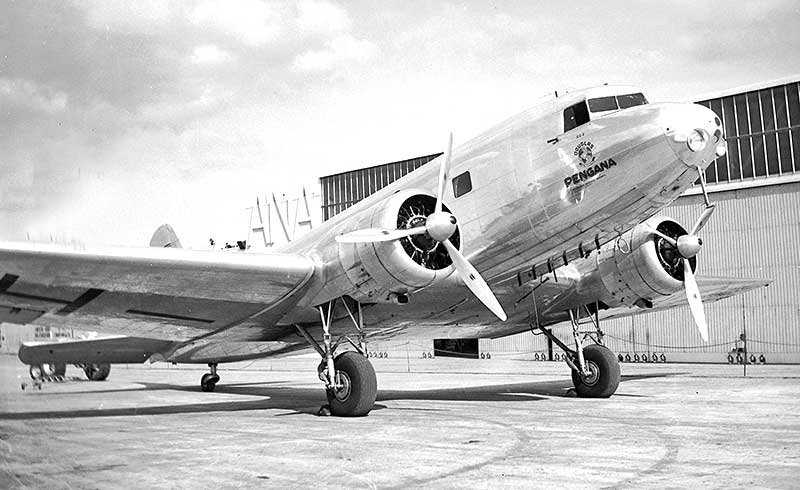
Photo: Maurice Austin collection
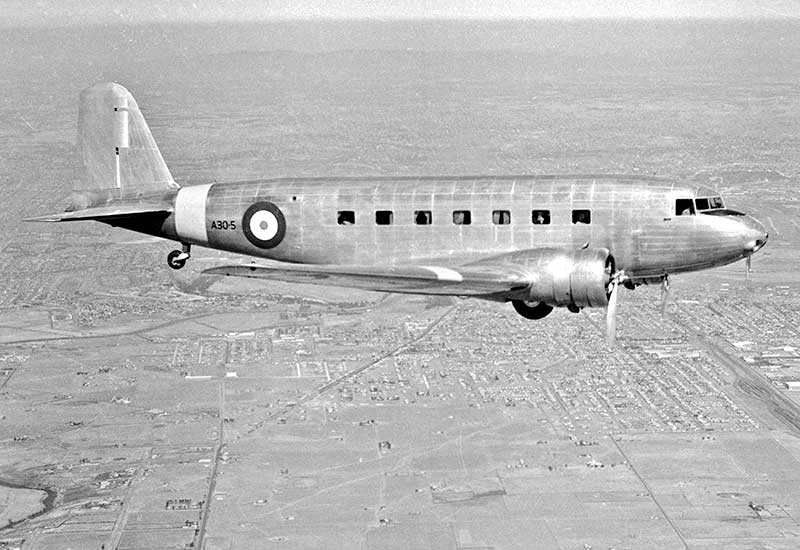
Photo by RAAF photographer John T. Harrison, courtesy Ben Dannecker collection
Holyman's Airways Pty Ltd immediately applied to CAB for import permits for DC-2s to replace its DH.86 biplanes on their Tasmania-Melbourne-Sydney services. G.A.Robinson's New England Airways, reformed as Airlines of Australia Ltd applied to import Stinson Model A trimotors and later a DC-2 and DC-3. Holyman's Airways became Australian National Airways Pty Ltd in November 1936.
The DC-2s proved an immediate success with Australian airlines, bringing a new world of comfort and reliability to air travel, including the first use of air hostesses. By the time they entered Australian service, Douglas was offering the enlarged and improved DC-3, four of which were imported prior to WWII.
820 hp Wright Cyclones. Passenger configuration was 12 to 14 seats. Australian National Airways DC-2s carried 14 passengers although for a period an extra passenger seat was trialled before reverting to 14.
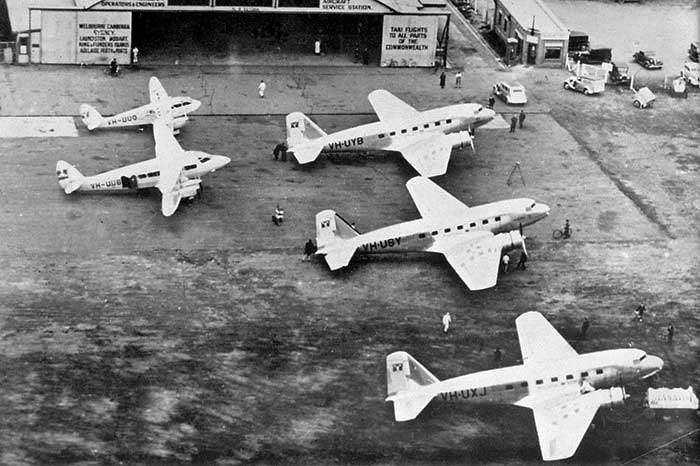

Passenger
cabin of ANA DC-2 VH-UXJ at Essendon, October 1937. Civil
Aviation Historical Society
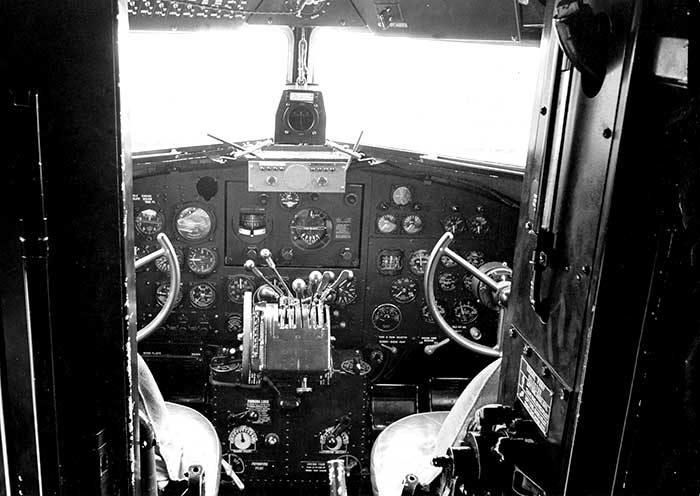
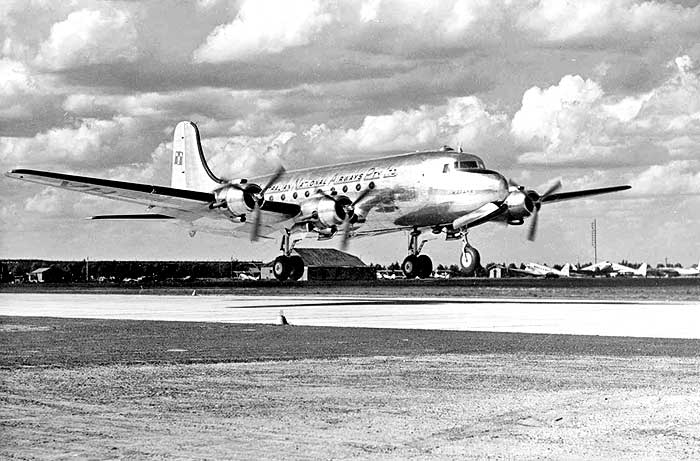
in the centre of the airfield, along with retired ANA DC-5 VH-ARD. Barrie Colledge collection
| 1934 |
KLM DC-2 Centenary Air Race London-Melbourne |
| 1936 |
Australian airline DC-2s |
| 1940 |
RAAF DC-2 order |
| 1942 |
Dutch KNILM DC-2s evacuated from Netherlands East Indies |
| 1942 |
USAAF C-33s and
C-39s in Australia with 5th Air Force SWPA |
| 1945 |
Post-war Australian civil use of former USAAF C-39s |
| 1984 |
Air Race 50th
Anniversary DC-2 flight London-Melbourne |
Race official Gerry Randall described the KLM entry: "It was most impressive in its simplicity. A circuit, landing, reporting, a meal, refuelling, a takeoff. There were no histrionics. The pilots wore their KLM uniforms and the quality of their airmanship made a deep impression on me." The air race success boosted KLM and Netherlands' standing as the world came out of The Great Depresion. Both Douglas and KLM capitalised by releasing a range of promotional "Uiver"mugs, plates, jigsaws and other many other souvenir items.
Unfortunately PH-AJU was to be destroyed in a tragic accident only two months later. However the bonds of frienship and gratitude forged by the KLM DC-2 visit are far-reaching for the Dutch community in Australia and between The Netherlands and the town of Albury. This continues to today with a series of civic commemoration events and memorials.
| .34 |
Built by Douglas Aircraft Co Inc at Santa Monica, California. Model DC-2-115A c/n 1317 |
| Ordered by Koninklijke
Luchtvaart Maatschappij NV - Royal Dutch Air Lines |
|
| 25.8.34 |
Douglas delivery date to KLM |
| Shipped to Holland,
assembled by Fokker at Schiphol Aerodrome, Amsterdam |
|
| 10.34 |
Entered
KLM service, named Uiver |
| 20.10.34 |
Departed Mildenhall
Aerodrome, London for Melbourne, painted with race number #44, flown
by KLM Captains K.D.Parmentier and J.J.Moll. 60,000 spectators watched the departures, commencing at 6.30am at 45 second intervals. PH-AJU was seventh to depart at 6.34am. |
| 23.10.44 |
Late evening on
the final leg inbound to Melbourne, caught in severe storm over northern
Victoria and crew became unsure of position. They held over
the lights of a town and such was the public excitement over the air
race that the town electricity suppy was interrupted to spell out
"Albury" in morse code. Albury had established airfield so townfolk
assembled on the racecourse to light a landing strip with car headlights.
PH-AJU landed at 1.20 am without damage but became bogged in the muddy surface. The DC-2 was pulled free by the citizens of Albury on ropes. In daylight Parmentier and Moll took off for Melbourne in a lightened aircraft, leaving their passengers behind at Albury. |
| 24.10.34 |
PH-AJU crossed
the finish line at Flemington Racecourse, Melbourne at 10.54am (local
time), the second contestant to finish behind C.W.A.Scott and T.Campbell
Black's DH.88 Comet G-ACSS Grosvenor
House. The DC-2 elapsed time from London was 90 hrs 13 mins, flying time 81 hrs 10 mins. It then landed at the nearby Laverton RAAF Station which was prepared to handle the race aircraft. |
| 1.11.34 |
Departed Melbourne
for the return flight to Amsterdam. The crew wished to stop
to thank Albury's citizens for their remarkable help during their
forced landing inbound to Melbourne. The nearest airfield capable
of handling the DC-2 was Cootamundra NSW, where a civic reception
was held for their visit. PH-AJU landed at Cootamundra at 10.30am with 15 on board, including race competitors Jean Batten and Colonel Roscoe Turner. Departed at 11.30am for Canberra for an official luncheon. |
| PH-AJU returned
to Amsterdam to a welcoming crowd of 50,000. The crew's achievements
during the air race had made them national heroes. |
|
| 19.12.34 |
PH-AJU departed
Schiphol Aerodome on a special KLM flight to Batavia carrying Netherlands
East Indies Christmas mail. PH-AJU was chosen to operate the service,
to promote its success in the recent MacRobertson air race. |
| 20.12.34 |
Crashed
in desert at Rutbah Wells, Iraq after being caught in a severe
storm. All 7 on board were killed, the wreck had burned and most mail
was scattered by the winds. |
| PH-AJU had departed Cairo at
23:30 local time bound for Baghdad. In the vicinity of Rutbah the
aircraft entered a storm and descended. It impacted the ground, crashed
and burst into flames. |

Kevin O'Reilly collection
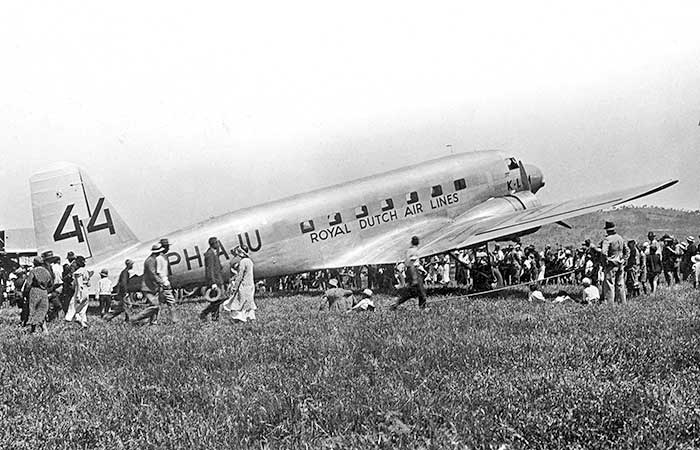
return flight from Melbourne to Amsterdam. A large crowd turned out for the visit on 1 November 1934
during which the crew gave their sincere thanks to the people of Albury. Ben Dannecker collection
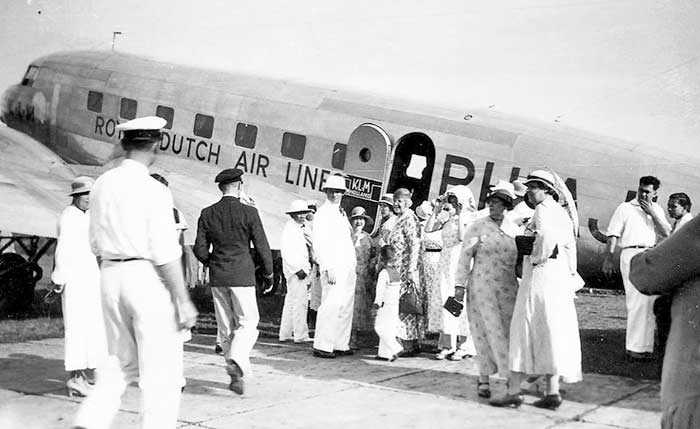
Amsterdam following the air race. The admiring crowd turns to greet the arriving KLM crew.
Photo: Jacques AC Bartels Collection via Noel Jackling
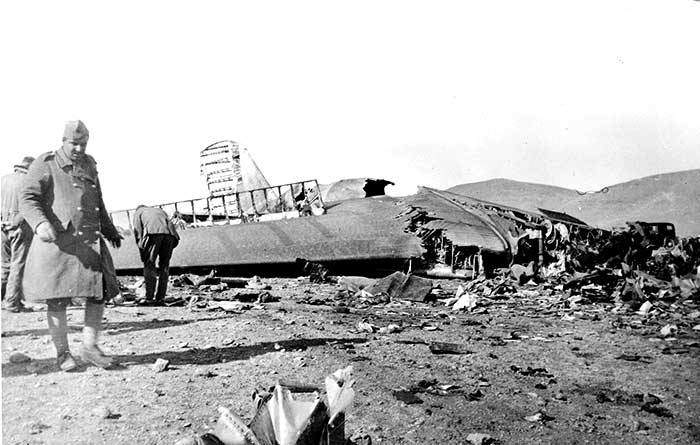
Both Matson Collection, via Bob Livingstone
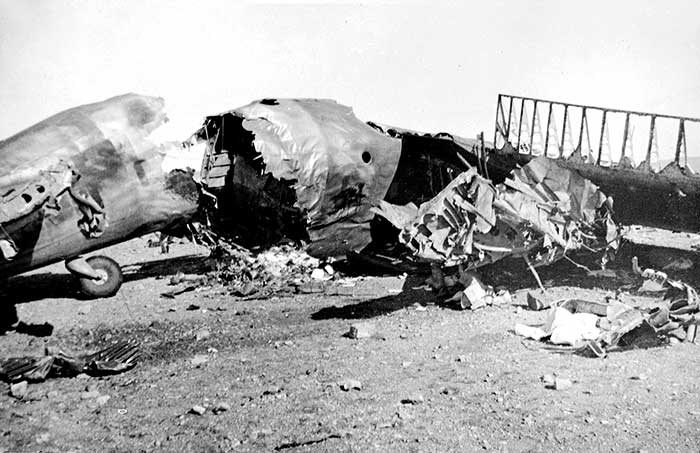
| Built by Douglas
Aircraft Co Inc at Santa Monica, California. Model DC-2-185 c/n 1580 |
|
| 28.1.36 |
Captain Ivan Holyman, Managing Director of Holyman's Airways Pty Ltd announced the order for a DC-2 which would be shipped to Australia on the SS Hauraki. |
| 10.4.36 |
Arrived at Port
Melbourne from California as deck cargo on board SS
Hauraki. |
| Moved by road to Essendon Aerodrome
where assembled in the Holymans Airways hangar under the supervision
of Douglas test pilot Major Victor E. Bertrandia and a Douglas engineer
who has accompanied the aircrat on the sea voyage |
|
| 28.4.36 |
First flight Essendon by Major
Bertrandia and HAL senior pilot Captain Ken Frewin |
| 29.4.36 |
Registered VH-USY
Holyman's Airways Pty Ltd,
Launceston Tasmania, Named Bungana, aboriginal for Chief |
| 29.4.36 |
Australian CofA issued. 14 passenger
seats |
| 30.4.36 |
Began a series of demonstration
flights, including a trial Melbourne-Sydney fight on 2.5.36 with a
direct flying time of 2hr 25 mins. |
| 5.5.36 |
Commenced reguar passenger service
with an 8am Sydney-Canberra-Melbourne under Captain Frewin |
| 13.5.36
Australian National Airways Pty Ltd was registered in Melbourne with
a nominal capital of £500,000 from Holyman's Airways Pty Ltd, Adelaide
Airways Ltd and several steamship companies. Merged operations of Holyman's Airways and Adelaide Airways as ANA to commence 2 November 1936 |
|
| 1.11.36 |
Ownership
transferred to Australian National
Airways Pty Ltd,. Melbourne Vic |
| 12.38 |
Flew an Imperial
Airways charter Melbourne-Calcutta return to collect Christmas air
mail for Australia |
| 8.2.40 |
Damaged in forced
landing near Dimboola Vic due starboard engine fire. The burning engine
fell out of its mounts at low altitude just before the aircraft landed
in a farm paddock, sustaining damage to belly and tailplane. No injuries.
Captain Norman W. Croucher, FO Arthur Lovell, Hostess Mavis Matters. Wings were removed and aircraft moved by road to Essendon for repair by ANA. |
| 2.2.42 |
Damaged at Forrest
WA when port undercarriage struck a large stone and collapsed, forcing
a strut into the wing structure. No injuries. Captain John
W. Knowling |
| 19.2.42 |
Starboard undercarriage
collapsed at end of landing run at Brisbane-Archerfield Qld. Reportedly
temporarily repaired using a wing loaned by USAAF. |
| 8.7.42 |
Damaged by exploding
land mine King Island aerodrome, part of wartime fortifications. No
injuries. Captain John W. Bennett, FO Bill Freeland. Port wing
replaced by a unit loaned by RAAF |
| 15.1.43 |
Damaged Cairns
Qld while operating a Directorate of Air Transport charter Townsville-Port
Moresby. While avoiding a bogged aircraft on the soft airfield
surface, VH-USY's undercarriage sank in mud damaging fuselage, wing
tip, engine cowlings and propellers |
| 10.9.46 |
Last
revenue service, Sydney-Melbourne. Captain George Totolis,
FO Jim Farrell, Hostess Anita Crowley. |
| 11.9.46 |
Withdrawn from service at Essendon
by ANA: airframe flying time 29,511 hours |
| Stripped of parts, parked near the reservoir in the centre of Essendon airfield with the other surviving ANA DC-2s and DC-5 VH-ARD. | |
| ANA donated VH-USY's instrument
panel to the Museum of Applied Science and Arts, Melbourne. It was later transferred to the collection of the Museum of Victoria |
|
| 11.12.47 |
Struck-off Civil
Register |
| .48 |
Sold for scrap |
| .48 |
Fuselage acquired
by K.Dallas, Red Cliffs Vic.
Moved by truck to Red Cliffs near Mildura where the fuselage was cut
off rear of the cockpit and converted to a caravan. - The nose section was sold to G.S.Beacham, Nangiloc Vic, who used parts on a motor boat Bungana. - Electrical cabling and switching was used in a travelling movie projector which toured country towns. - The name Bungana was cut out of the nose metal and made into a name plate. In 1979 it was donated to the Launceston Airport museum collection. |

Photo John Hewson via Fred Niven collection
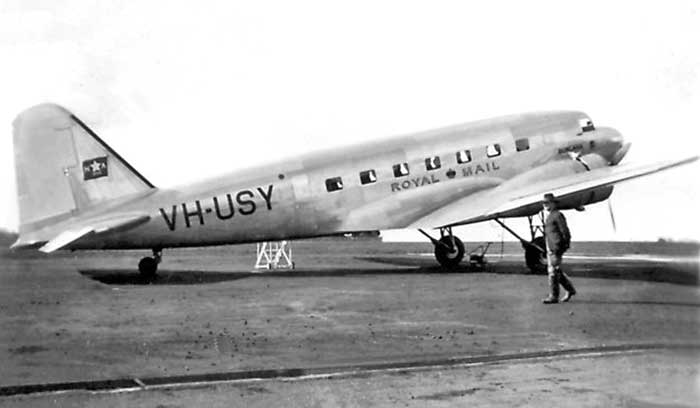
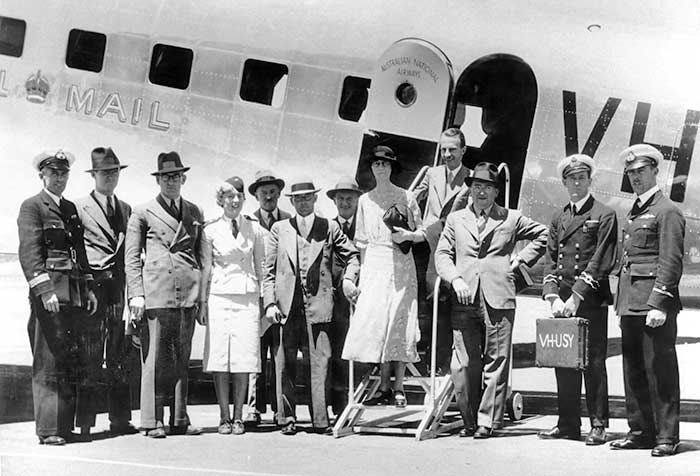
March
1937 VH-USY makes the first ANA DC-2 Perth-Adelaide service . It took
all day with stops at Ceduna,
Forrest and Kalgoorlie but was a big improvement over the biplane service with night stops at Forrest each way.
Captain Harry Baker at left, First Officer Bill Heath far right with radio operator W.E. Lauder-Cridge, hostess
Gladys Allen. Note "Australian National Airways" on the door. CAHS Mac Job collection
Forrest and Kalgoorlie but was a big improvement over the biplane service with night stops at Forrest each way.
Captain Harry Baker at left, First Officer Bill Heath far right with radio operator W.E. Lauder-Cridge, hostess
Gladys Allen. Note "Australian National Airways" on the door. CAHS Mac Job collection
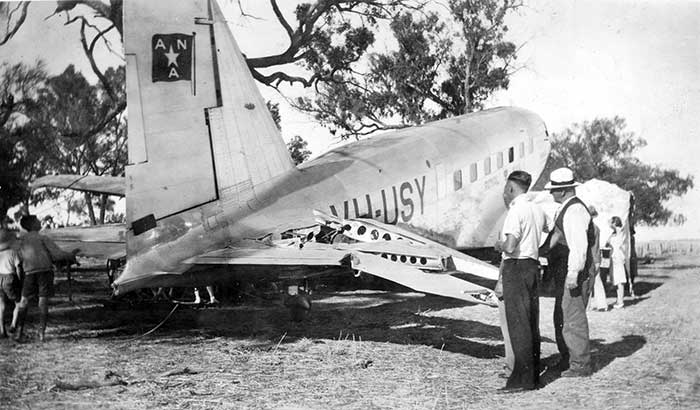
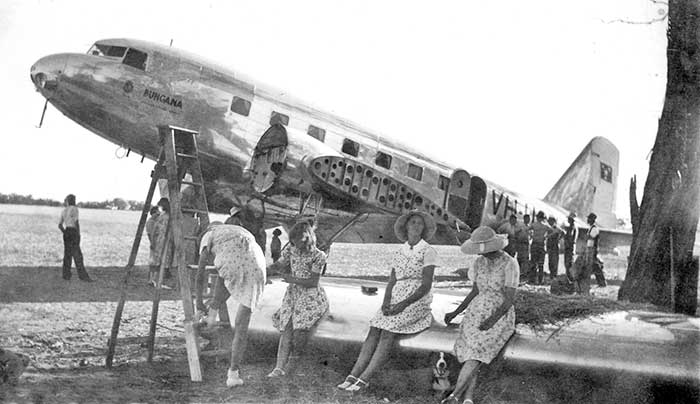

Photo by Bob Fripp
| 10.7.36 |
Built by Douglas Aircraft Co Inc at Santa Monica, California. Model DC-2-199 c/n 1561 |
| Ordered
by Holyman's Airways Pty Ltd as their second DC-2. (During 1936 Holyman's Airways and Adelaide Airways Ltd agreed to merge. On 13.5.36 Australian National Airways Pty Ltd was registered in Melbourne with a nominal capital of £500,000 from Holyman's Airways Pty Ltd, Adelaide Airways Ltd and several steamship companies. Merged operations of Holyman's Airways and Adelaide Airways as ANA to commence 2 November 1936) |
|
| 19.9.36 |
US CofA issued |
| 30.11.36 |
Arrived at Port Melbourne from California as deck cargo on board SS Hauraki. |
| Moved by road to Essendon Aerodrome where assembled in the ANA hangar. | |
| 4.12.36 |
First test flight Essendon by
ANA Captain Clarrie Scott |
| 4.12.36 |
Registered
VH-UXJ Australian
National Airways Pty Ltd,. Melbourne Vic Named Loongana, aboriginal for Swift. The name had also been used by a well-known Bass Strait ferry boat between Melbourne and Tasmania. |
| 4.12.36 |
Australian CofA
issued. 14 passenger seats. It was fitted with floatation gear because
it was intended to be used mainly on the original Holyman's Airways
routeacross Bass Strait between Melbourne and Tasmania. |
| 5.12.36 |
Commenced revenue
service |
| 20.1.39 |
Nominal change of ownership to Airlines of Australia Ltd, Sydney NSW |
| 1.39 |
Hired over next 6 months by
Guinea Airways Ltd, Adelaide when needed for the Adelaide-Darwin route
to replace their Lockheed 14 VHABI which crashed at Katherine NT on
19.1.39. |
| 21.9.39 |
Ownership transferred back to Australian National Airways Pty Ltd, Melbourne Vic |
| 14.2.42 |
Struck aerodrome
boundary fence during landing on wet surface at Mackay Qld. No injuries.
Captain T. E.Shersby, FO Jim Turner, hostess Donaldson. |
| 5.5.42 |
Struck aerodrome
boundary fence during landing on wet surface at Mackay Qld. No injuries.
Captain Lou Lohse, FO Arthuer Malpass |
| 30.12.42 |
Starboard undercarriage partially
collapsed taxying at Essendon, wing tip damage. No injuries. Captain Doug R. Way, FO Frank Fischer |
| 27.7.46 |
Both outer wings damaged in
a ground loop, location not recored |
| 4.10.46 |
Last revenue service. |
| 10.46 |
Stripped of parts, parked near the reservoir in the centre of Essendon airfield with the other surviving ANA DC-2s and DC-5 VH-ARD. |
| 19.12.47 |
Struck-off Civil Register |
| .48 |
Broken-up for
scrap |

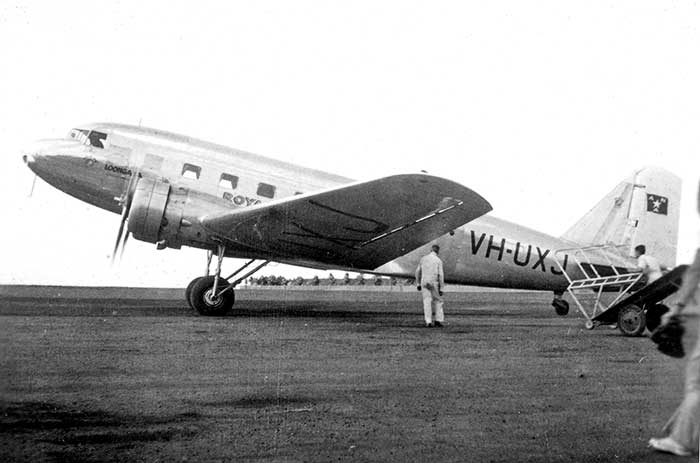
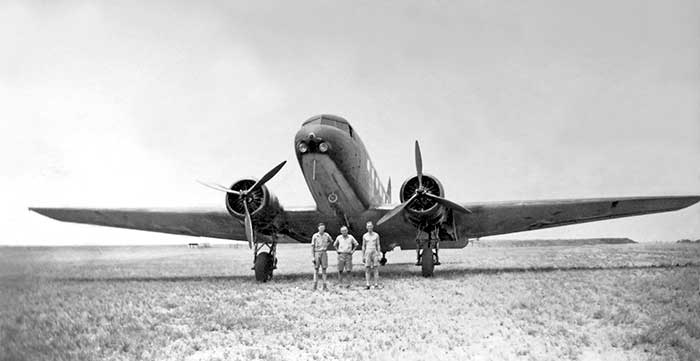
Captain Doug Secombe is on right, Dick Probyn centre. Photo via Bruce Robinson
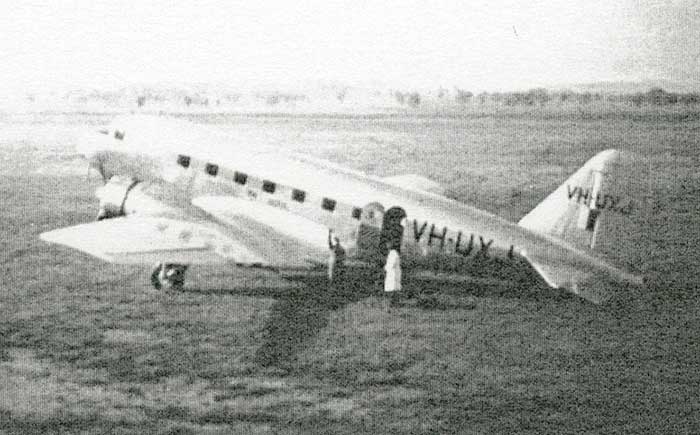
| 15.4.37 |
Built by Douglas Aircraft Co Inc at Santa Monica, California. Model DC-2-210 c/n 1563 |
| Ordered by Australian National
Airways Pty Ltd, Melbourne Vic |
|
| 20.4.37 |
First flight Santa
Monica |
| Shipped to Melbourne
as deck cargo on board SS Limerick |
|
| 2.7.37 |
Registered VH-UYB Australian National Airways Pty Ltd, Melbourne Vic |
| 2.7.37 |
First test flight Essendon after
assembly, ANA Captains Harry Baker and Len Diprose |
| 2.7.37 |
Australian CofA
issued. 14 passenger seats |
| 4.7.37
|
Entered ANA service:
Melbourne-Adelaide-Ceduna-Forrest-Kalgoorlie-Perth |
| 1.39 |
Hired over next 6 months by Guinea Airways Ltd, Adelaide when needed on the Adelaide-Darwin route to replace their Lockheed 14 VHABI which crashed at Katherine NT on 19.1.39. |
| 30.6.39 |
Ownership transferred
to Airlines of Australia Ltd,
Sydney NSW |
| 21.9.39 |
Ownership transferred back to Australian National Airways Pty Ltd, Melbourne Vic |
| 28.9.39 |
Forced landing
in Cooks River, adjacent to Mascot Aerodrome, Sydney after power loss
immediately after takeoff. Captain Doug R.Way, FO Andy Munro, Hostess
Dorothy Webster, no injuries Aircraft was painted as Airlines of Australia and name Pengana. |
| Salvaged, damaged
airframe sent to Melbourne by ship. Repaired by ANA at Essendon |
|
| 9.12.39 |
Test flight Essendon after repairs
completed |
| 24.12.40 |
Wing tip damaged
when struck ground during landing at Mount Gambier SA in a strong
gusty crosswind. No injuries, Captain Arthur Lovell |
| 11.12.41 |
Arrived in New Guinea on a RAAF
charter |
| 18.11.42 |
Damaged in ground collision
while parked at Townsville-Garbut Field. Repaired using two outer
wings supplied by the Garbutt USAAF Depot |
| 17.8.46 |
Withdrawn from service. Total
flying hours 29,511 hours |
| 11.12.47 |
Stripped of parts and parked near the reservoir in the centre of Essendon airfield with the other surviving ANA DC-2s |
| 19.12.47 |
Struck-off Civil Register |
| .48 |
Broken-up for scrap. |
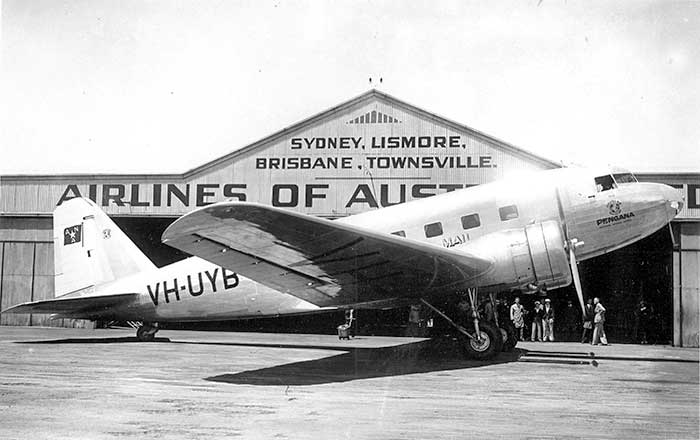
Frank Walters collection
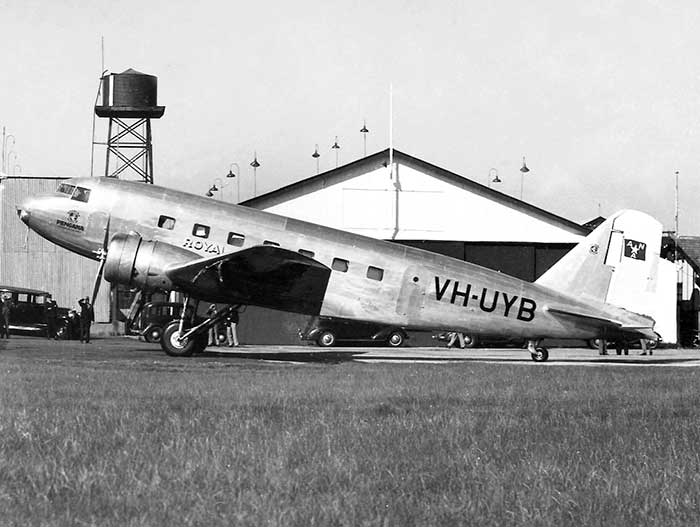
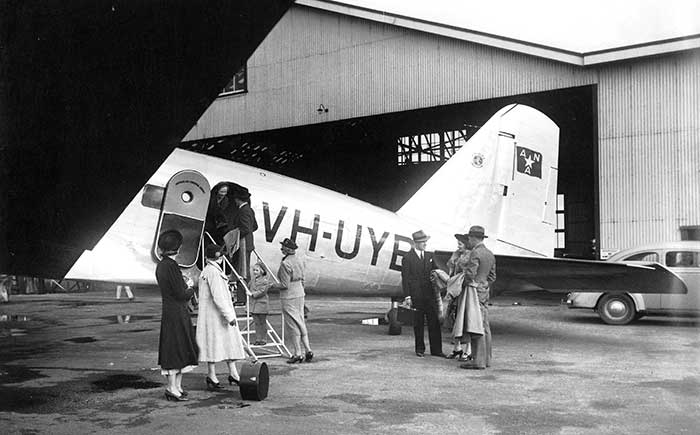
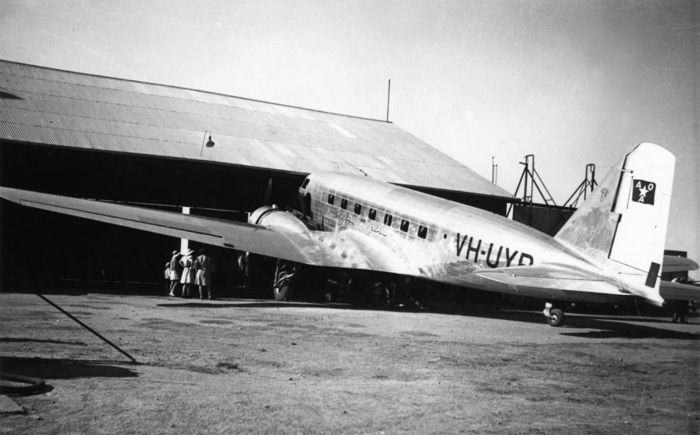
Pictured at Townsville's pre-war Ross Plains airfield on a scheduled AoA service. Townsville City Library
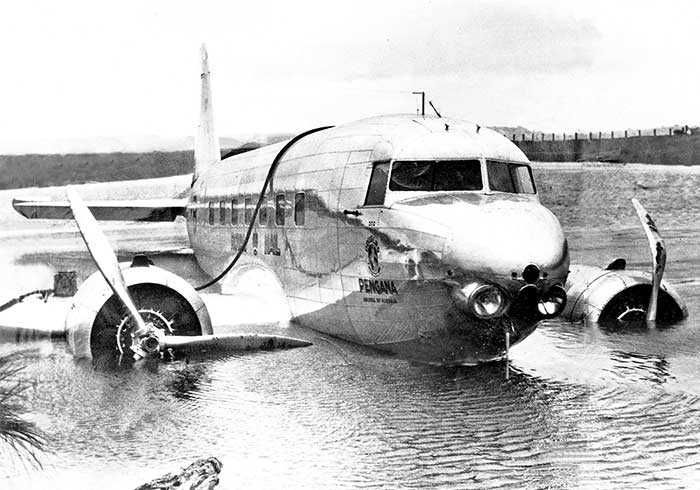
At this time "Pengana" had Airlines of Australia markings. Ed Coates Collection
| .37 |
Built by Douglas Aircraft Co Inc at Santa Monica, California. Model DC-2-210 c/n 1566 |
| 14.4.37 |
G.A.Robinson,
Managing Director of Airlines of Australia Ltd announced the purchase
of two new Douglas airliners, a DC-2 for delivery that June and a
DC-3 at the end of the year. |
| In March 1937 ANA had acquired
financial control of AoA, the two airlines initially continuing to
operate under their separate names but on integrated services. ANA
covered Melbourne-Adelaide-Perth and Tasmania, AoA Melbourne-Sydney-Brisbane-Townsville. AoA was finally absorbed into ANA effective 1 July 1942 |
|
| DC-2 shipped to
Melbourne as deck cargo on board SS
Waiotapu |
|
| Moved by road from Port Melbourne
to Essendon Aerodrome for assembly by ANA |
|
| 30.7.37 |
Registered VH-UYC Airlines of Australia Ltd, Sydney NSW |
| 30.7.37 |
Australian CofA
issued. 14 passenger seats |
| 1.8.37 |
Entered commercial
service with AOA on their Sydney-Brisbane route |
| 1.12.37 |
Ownership transferred to Australian National Airways Pty Ltd, Melbourne Vic |
| 19.1.38 |
Forced landing
in a paddock near Somerton Vic just north of Melbourne . No injuries,
Captain P.T.L.Taylor. Minor damage repaired on site and aircraft flown out. |
| 25.10.38 |
Crashed
Mount Dandenong near Melbourne Vic. All 18 on board were killed. |
| The aircraft overflew
Essendon in cloud inbound from Adelaide and struck trees on slopes
near the peak of Mount Dandenong near Olinda, shearing off wings and
tailplane before crashing in flames. Captain A.C.D.Webb, FO Alan J. Steen, trainee pilot Phillip Pring, Hostess Elva Jones and 14 passengers. Radio navigation aids to allow pilots to accurately home on airports had not yet been installed in Australia. |
|
| A
detailed summary of the accident, the subsequent enquiry and its impact
on the Australian airways system can be found in the highy recommended
book"Air Crash" Volume 1 (Aerospace Publications 1991) by Australian
air safety expert Macarthur Job. |
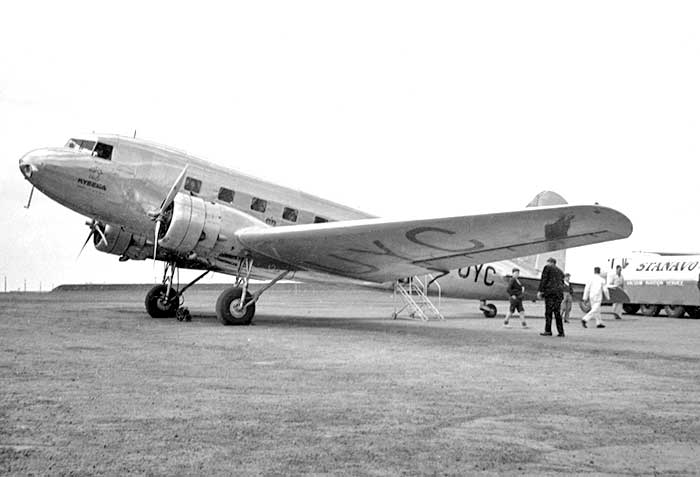
Photo: Civil Aviation Historical Society collection
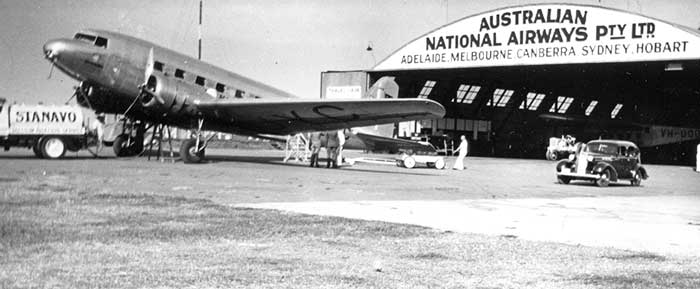
Photo: Australian Aircraft Restoration Group collection
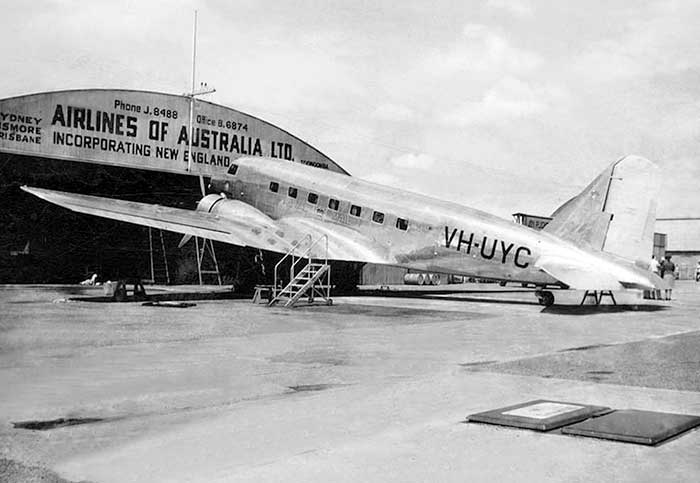

When WWII broke out in September 1939, Australian political and military complacency had left the RAAF severely under equpped for combat and with no useful transport capability. Four DC-3s were immediately taken over from ANA and Airlines of Australia and given RAAF serials A30-1 to A30-4.
The British Purchasing Commission in Washington DC reported a lengthy delay in acquiring the preferred Dougas C-47 transports for Britain or Australia because of large US military orders already placed. After negotiation with manufacturers and American aircraft brokers, the commission recommended that the Australian Government purchase of the remaining 10 Eastern Airlines DC-2s recently retired from airline service. They were being offered as a package with a substantial spare parts holding by established aircraft brokers Charles H. Babb Co, Grand Central Air Terminal, Glendale California.
It was a compromise, but the DC-2s were available immediately and early shipping to Australia could be arranged. The Australian War Cabinet agreed and the BPC purchased them on behalf of the Australian Government. They joined the RAAF as A30-5 to A30-14 and were to prove invaluable throughout the war as freight and personnel transports, submarine patrols, patroop training, wireless air gunner operator training and other tasks.
Cargo doors
During the early days of the New Guinea Campaign, RAAF command realised
the need for wide cargo doors for DC-2s to load bulky cargo and spare aircraft
engines and complete propellers. The Department of Civil Aviation's Aeronautical
Engineering Branch under senior aeronautical engineer John L.Watkins was
tasked with designing a modification, which was first installed in A30-10
in the ANA workshops at Essendon Aerodrome over six weeks under the supervision
of ANA engineer D.S.Stewart who had two teams of 18 RAAF fitters, working
two 12 hour shifts a day. The fuselage structure around the
door was stiffened by adding a second fuselage metal skin. In
his report on the conversion, Watkins stated it was "the biggest structural
modification to a stressed skin aircraft undertaken in Australia". The rectangular cargo door was large enough to load the then largest aircraft engine complete with cowlings and the cabin floor was strengthened for stowage of engines weighing over a ton . A mobile crane on four rubber tyres was built to lift an engine into the DC-2, where it was mounted in fabricated engine transport stands with skids that locked on to steel rails built into the cabin floor. The crane could be dismantled into 5 sections for stowage on board to the destination. In addition a winch was provided in the forward cabin to pull cargo up the sloping floor when loading. To transport complete propeller assemblies up to 12 feet 6 inches diameter, a mandrel was built into the underbelly of the centre-section, to which the propeller was mounted the same way as an engine's propeller shaft.
DC-2s A30-11 and A30-14 were then similarly modified by ANA at Essendon

Ed Coates Collection
| .34 |
Built by Douglas Aircraft Co Inc at Santa Monica, California. Model DC-2-112 c/n 1287 |
| 10.34 |
Registered NC13737 General Air Lines Inc, New York NY |
| 15.12.34 |
Renamed Eastern Air Lines Inc, New York NY |
| .40 |
Sold to Australian
Government |
| 20.9.40 |
Shipped ex USA as deck cargo on board MV City of Sydney |
| 18.11.40 |
Taken
on RAAF charge as A30-5.
Assembled by ANA at Essendon Aerodrome, Melbourne |
| 2.12.40 |
Serviceable at
ANA |
| 6.12.40 |
Received No.1
Aircraft Depot, Laverton ex ANA for wireless mods |
| 12.12.40 |
Pilot log: Laverton local flight,
P/O Peter J.Gibbes |
| 27.12.40 |
Torn from moorings
on ground by strong winds, port and stbd wing tips damaged |
| 12.1.41 |
Received No.1
Wireless Air Gunner School, Ballarat |
| 13.2.42 |
Pilot log: Ballarat local flight, Flt Lt Basil B. Daish, P/O Peter J.Gibbes |
| 20.5.42 |
Issued ANA Essendon
ex 1WAGS for mods |
| 1.6.42 |
Received 3WAGS
Maryborough ex ANA |
| 4.7.42 |
Damaged landing Maryborough.
Brakes locked, aircraft swung and struck obstructions on the side
of the runway. Starboard tailplane, elevator and flap damaged. No
injuries. pilot W/O Bert Starkey |
| 22.7.42 |
A30-5 allotted to 36 Sqn when
serviceable. Training equipment in A30-5 to be transfered to A30-13.
|
| 39.42 |
Issued to No. 36 Squadron, Essendon
ex 3WAGS |
| 13.9.42 |
Collected at Archerfield by
36 Sqn crew F/Lt Stewart Devine and copilot LAC Foers. Departed for
Port Moresby via refuelling stops at Rockhampton and Townsville.
Overnighted at Townsville |
| 14.9.42 |
Departed Townsville for Port
Moresby via refuelling stop at Cooktown. Departure Cooktown was after
the latest time to reach Moresby before last light . Arrived over
Port Moresby in the dark and Devine flew an incorrect approach circuit
during which the aircraft struck a hill and was destroyed |
| 14.9.42 |
Crashed
into hill near Seven Mile Strip, Port Moresby, New Guinea. Struck hill during night landing approach, exploded in flames destoying the aircraft and its cargo. F/Lt S.Devine, LAC Foers, F/Sgt Alber, Sgt Daily, Sgt Beitz (American serviceman passenger) killed. |
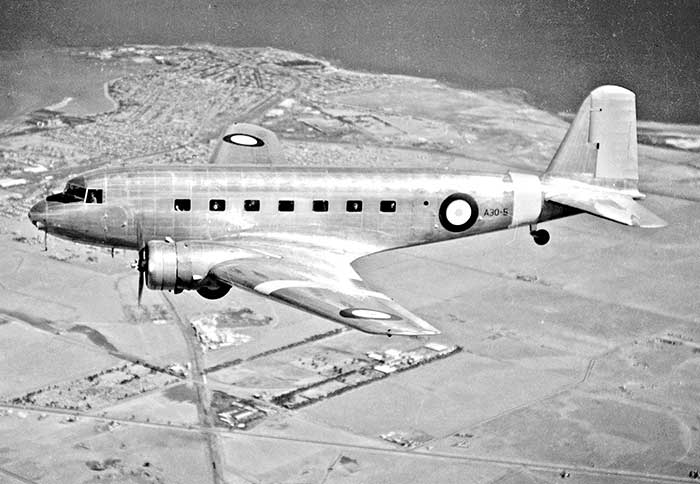
yellow training bands on fuselage and wings. Photo by John T. Harrison via Ben Dannecker coillection
| .34 |
Built by Douglas Aircraft Co Inc at Santa Monica, California. Model DC-2-112 c/n 1259 |
| 4.10.34 |
Registered NC13733 General Air Lines Inc, New York NY |
| 15.12.34 |
Renamed Eastern Air Lines Inc, New York NY |
| .40 |
Sold to Australian Government |
| 20.9.40 |
Shipped ex USA as deck cargo on board MV City of Sydney |
| 6.12.40 |
Taken
on RAAF charge. Received ANA Essendon ex USA for assembly |
| 12.12.40 |
Received No.1
Aircraft Depot Laverton ex ANA for wireless equipment wiring |
| 13.1.41 |
Issued No.1 Wireless
Air Gunners School, Ballarat ex 1AD |
| 27.3.41 |
Issued to Signals
School, Point Cook |
| 13.4.41 |
Issued to 1AD
ex Signals School |
| 16.10.41 |
Issued 1WAGS Ballarat
ex 1AD |
| 7.12.41 |
Ran through fence
during landing, minor damage |
| 18.8.42 |
Allotted to 36
Sqn ex 1WAGS. Instructional equipment to be removed prior to
delivery. |
| 20.8.42 |
Received No.36
Squadron, Essendon for transport duties |
| 8.42 |
Directorate of Air Transport
Allied Air Forces issued radio callsign VHCRJ
which was painted on the aircraft |
| 12.42 |
36 Squadron moved base to Townsville
with detachments at Essendon and New Guinea |
| 7.12.42 |
A30-6 repositioned from Essendon
to Townsville, departed that day, pilot Flt Lt. Harry Clark,
carrying 12 personnel. Arrived Townsville 11.12.42 after delay for repairs to minor damage on landing enroute. |
| 13.12.42 |
A30-6 flew freight Townsville-Iron
Range, F/O Ken Arnold, P/O Frank Ball, Sgt Stan Cross, LAC Bill Cousins |
| 18.12.42 |
A30-6 flew Townsville-Cooktown-Port
Moresby, F/O Ken Arnold, F/Sgt Thomas (copilot),Sgt Snow Picton (Wireless
Operator), LAC Norm Parker (fitter). Norm
Parker later wrote: "The starboard engine had a bad oil leak in the nose section. We were so short of aircraft that the time to remove the nose section and fix the leak was not available. At Cooktown, while taxying along a dispersal road, one of the main wheels went through the surface and th aircraft was bogged. By the time we were free it was too late to go on, so we stayed the night. On arrival at Port Moresby the next day the weather became so bad we had to stay there the rest of the day. We left Moresby before daylight next morning. There were twelve passengers with all their gear, most of them Americans. 30 miles out from Townsville the red warning light for low oil pressure in the starboard engine came on. F/O Arnold did not want to shut down the engine but on my insistence he did. DC-2 airscrews were not equipped for feathering, so it continued to rotate. When we turned right over Magnetic Island, the required war time approach to Townsville, we were turning into the dead motor but Ken Arnold kept control and headed for Stock Route Strip. I was standing behind the pilots, the usual position for the fitter, with one hand on the wobble pump handle.The strip was coming up fast, much faster than normal as he kept the speed up. A30-6 hit the deck very hard but nothing broke and it stayed on the strip. We taxied to the far end of the strip where a very shaken crew and passengers alighted." |
| 21.12.42 |
Townsville-Iron Range return,
crew F/O Rod Kreig, Wireles Op Ian Wall, Sgt Stan Cross, LAC Sam Wiles. Returned with starboard engine shut down out of oil again. |
| 22.12.42 |
Starboard engine repaired at
Stock Route Strip, oil seals replaced. |
| 23.12.42 |
Crashed
during landing at Stock Route Strip Townsville Qld. Accident occurred at 10.45am during landing after a full-load test flight after right engine maintenance, carrying a full load of Army and 36 Sqn personnel. A swing off the runway had been corrected and aircraft was running parallel to the runway when the port main wheel struck a heap of gravel, causing the port undercarriage to collapse and aircraft to swing violently to the left. Pilots Flt Lt H.R.Clarke and F/O J.E.Mullaney, no injuries. |
| 23.12.42 |
Damaged aircraft
assigned to No.12 Repair and Salvage Unit, Townsville-Garbutt
Field |
| Damage assessed as: Mainplanes: port and starboard damaged beyond repair Fuselage: right side of cockpit completely wreck extending to cabin bulkhead, left side forward fuselage slight damage, rear left side damaged Empennage: port tailplane damaged beyond repair Fin and rudder slighly damaged Centre section: badly damaged beyond RAAF repair limits Undercarriage: damaged beyond repair Cockpit instruments: all smashed including Sperry panel Engines and propellers: starboard beyond repair, port badly damaged but repairable |
|
| 29.4.43 |
Allotted ANA Essendon
for repair. Delay arranging shipping from Townsville to Melbourne |
| 24.6.43 |
Damaged airframe
received ANA Essendon. |
| 9.10.43 |
On completion of repairs aircraft
to be loaned to Department
of Civil Aviation for issue to civil airlines |
| 25.11.43 |
Aircraft completed at ANA Essendon,
retaining cabin lining and passenger seating attachment points for
14 chairs. |
| 26.11.43 |
Registered VH-ADQ
Commonwealth of Australia,
operated by Australian National Airways Pty Ltd, Melbourne
Vic |
| 26.11.43 |
Approved by DCA for ANA use
on an "Authority To Operate". No CofA was issued to VH-ADQ. |
| 27.11.43 |
Entered commercial service with
ANA. Named Mungana |
| 2.12.43 |
Pilot log: VH-ADQ Brisbane-Sydney-Melbourne,
Cpt Knowling, FO Charles D. Pratt |
| 4.12.43 |
Extensively
damaged in forced landing near Bendigo Vic. Scheduled ANA Brisbane-Sydney-Melbourne service. Radio compass was u/s and very poor radio reception resulted in crew becoming unsure of position inbound to Melbourne with an ETA of 0320 Local time. After circling a large town in the dark, by time 0420 fuel state was so low that a forced landing was made in a clear area near the town. Flares were dropped to illuminate a farm paddock. Towards the end of the landing roll the aircraft struck a fence and dense trees, tearing off the undercarriage and outer wings. The right side of the cockpit was crushed, killing FO Herbert V.Kenna. Captain Kevin T.E.Shersby, Hostess June Westbrook and 6 passengers escaped with minor injuries. |
| 12.43 |
Badly damaged aircraft moved
by road to ANA hangars at Essendon. |
| Still critically short of aircraft
to maintain reducted civilian wartime services, ANA negotiated with
RAAF to acquire the wrecked airframe as a rebuild project |
|
| 12.4.44 |
Registration application: Australian
National Airways Pty Ltd, Melbourne Vic. ANA state that fuselage, centre-section, tail unit, undercarriage and engines are "of RAAF origin", mainplanes from VH-ADQ, wheel units are local manufacture and propellers imported from Hamilton Standard in USA |
| Because of the mixed heritage
of the rebuilt aircraft, DCA allocated a new registration VH-AEN |
|
| 16.4.44 |
Weighed on DCA scales at Essendon
on completion of rebuild. |
| 16.4.44 |
Approved by DCA for ANA use
on an "Authority To Operate" pending formal issue of CofA |
| 17.4.44 |
VH-AEN entered commercial service,
Essendon-Parafield-Ceduna-Forrest-Kalgoorlie-Perth. ANA named the aircraft Mungana |
| 18.4.44 |
Port undercarriage collapsed
while taxying at Maylands Aerodrome, Perth for departure to Kalgoorlie.
Repairs completed 21.4.44 |
| 25.4.44 |
Forced landing Bonnie Vale,
18 miles west of Kalgoorlie at 8.15am, no damage. The cockpit fuel
tank selector switch had failed. VH-AEN had departed Maylands at 6.25am
WST on a scheduled Perth-Kalgoorlie-Melbourne service.
Captain Arthur Lovell, FO Keith L.Richards. The passengers were taken to Kalgoorlie by road. ANA engineers and parts were flown from Maylands to Kalgoorlie in MMA's Cessna C34 VH-UZU, then by road to forced landing site. Captain Lovell flew the DC-2 out to Kalgoorlie at 5.30pm that afternoon |
| Formal certification delayed
due to DCA concern over correct model of this DC-2. DCA Head Office
wrote to ANA Chief Engineer asking for its origins. His reply states
this aircraft is a rebuild of DC-2 VH-ADQ: - fuselage, centre-section and engines are original Eastern Airlines purchased from RAAF as A30-6; - mainplanes including ailerons are from VH-ADZ ex KNILM; - tail unit and undercarriage are new from RAAF spares stocks; - wheels, tyres and tubes were locally manufactured. |
|
| 5.5.44 |
CofR and CofA issued VH-AEN
Australian National Airways
Pty Ltd, Melbourne Vic |
| 8.46 |
Based Perth-Guildford operating
ANA Perth-Kalgoorlie-Forrest-Ceduna-Adelaide scheduled services to
supplement the ANA DC-4 services Perth-Adelaide direct. VH-AEN still
based Perth by 1.47 |
| 18.4.47 |
CofA expired, not renewed by
ANA. Retired at Essendon and advertised for sale |
| 9.1.48 |
Change of ownership: New
Holland Airways, Sydney NSW |
| Ferried Essendon-Mascot by New
Holland Airways founder Gregory Board. |
|
| 2.4.48 |
CofA renewed Mascot |
| New Holland Airways specialised
in charters bringing European migrants to Australia, mostly from Rome
and Athens. See The Migrant
Caper on this site |
|
| Gregory Board later wrote: “I bought the old DC-2 VH-AEN from Australian National Airways at Essendon together with the DC-5 VH-CXC. Both airplanes were in good condition although their airworthiness certificates were expired. They came absolutely complete with all radio, catering equipment and even blankets for the passengers. Both aircraft were parked at Essendon when I bought them and I took them up to Camden or Bankstown, I cannot remember which, as our maintenance section was originally at Camden and later moved to Bankstown. I also had for New Holland Airways around that time, about three Lockheed Hudsons and Lockheed Lodestar VH-GRB, as well as an Italian registered DC-3 I- TROS. All of these aircraft were used to transport immigrants from Rome, Athens and Singapore." |
|
| 9.5.48 |
Swung
off runway landing Darwin NT, badly damaged. No injuries. |
| 28.5.48 |
Letter to DCA from New Holland
Airways advising that the company is in discussions with their insurance
company whether to repair AEN at Darwin. |
| 7.9.49 |
Letter to DCA from New Holland
Airways advises VH-AEN will not be repaired |
| 3.12.48 |
Struck-off Civil Register |
| Gregory Board later wrote:
"Of all our New Holland Airways
aircraft only one never made a trip to Europe and that was the DC-2
VH-AEN. The pilot we hired for it, Keith Robey evidently could not
handle the differential hand brake and ran off the runway in Darwin
on its maiden flight to Rome. It was a total write off. I was
overseas at the time and missed the episode.”
|

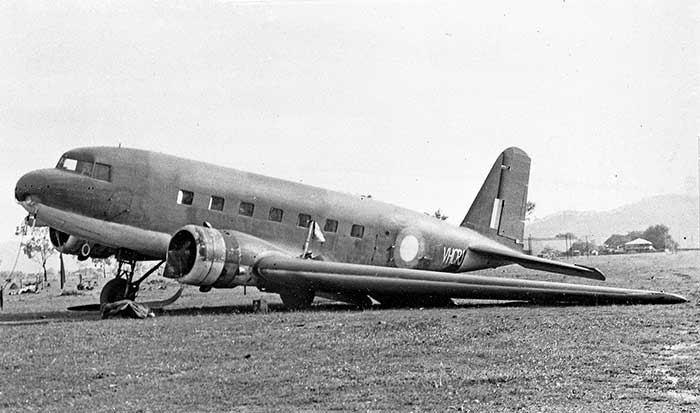
Neil Follett collection

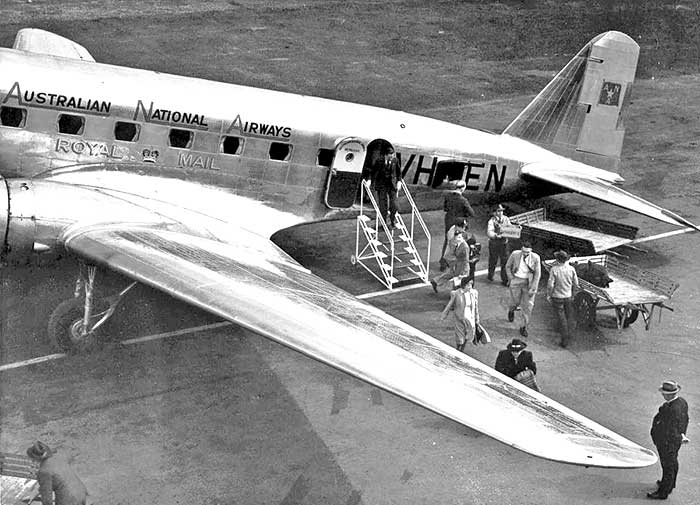
Seen from the Essendon ANA passenger terminal roof observation deck in 1945. Fred Niven collection
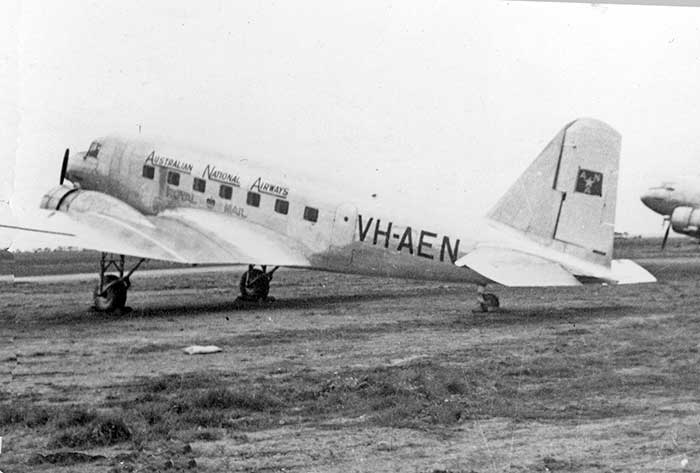
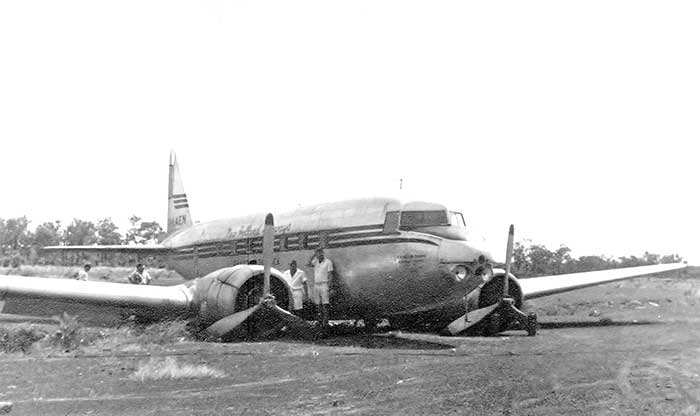
These two photographs come from Cherry Williamson via Ron Cuskelly.
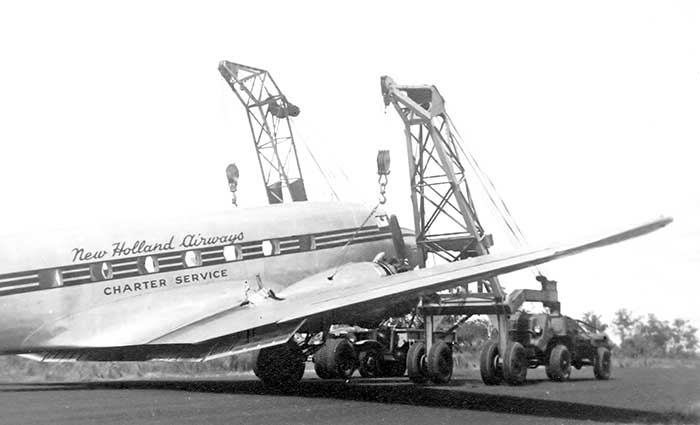
| .34 |
Built by Douglas Aircraft Co Inc at Santa Monica, California. Model DC-2-112 c/n 1290 |
| 11.34 |
Registered NC13740 Eastern Air Lines Inc, New York NY |
| Sold to Australian Government, shipped to Australia as deck cargo on MV Port Chalmers | |
| 21.12.40 |
Taken on RAAF
charge as A30-7. Received
ANA Essendon ex USA for assembly |
| 31.12.40 |
Received 1AD Laverton
ex ANA |
| 2.3.41 |
Issued No.1 Wireless Air Gunners School, Ballarat ex 1AD |
| 7.6.41 |
Received 2WAGS
Parkes ex 1WAGS |
| 15.6.42 |
Crashed
at Parkes Aerodrome NSW, complete writeoff. Stalled from 200 feet during day circuit training. 3 aircrew and 8 RAAF passengers on board were injured. |
| .34 |
Built by Douglas Aircraft Co Inc at Santa Monica, California. Model DC-2-112 c/n 1291 |
| 11.34 |
Registered NC13781 Eastern Air Lines Inc, New York NY |
| Sold to Australian Government, shipped to Australia | |
| 3.1.41 |
Taken on RAAF charge as A30-8. Received ANA Essendon ex USA for assembly |
| 9.1.41 |
Received 1AD Laverton ex ANA |
| 2.2.41 |
Received Signals
School, Point Cook ex 1AD |
| 1.6.41 |
Issued No.2 Wireless
Air Gunner School, Parkes ex Signals School |
| 26.1.42 |
Shot
down by Japanse fighters, ditched in sea Sumba Strait, Netherlands
East Indies. The DC-2 flown by 2WAGS crew F/O Noel Webster and copilot Sgt Lionel Van Praag who had volunteered for an urgent special mission to carry USAAF P-40 Kittyhawk ground crews and aircraft spares from Australia to Sourabaya during the Japanese invasion of Netherlands East Indies. It was attacked on the return flight after departing Sourabaya for Koepang, Timor then Darwin. |
| The DC-2 was badly damaged and
was ditched at sea in the Sumba Strait between Flores island and Sumba
Island. Van Praag and Corporal Fred Mason had bullet flesh wounds.
Radio operator Sgt Eric Picker continued sending morse code SOS signals
with their position until the ditching when he locked the morse key
down to send continuous distress signal. The 4 crew abandoned
the aircraft just before it sank, floating away with just a tin of
drinking water and their Mae West life jackets tied together. One
Mae West had been holed by a Japanse bullet. They drifted together in the sea for 33 hours, losing consciousness and hallucinating, at times firing their service revolvers at circling sharks which were brushing their legs, before being washed up on an island, all suffering coral cuts while reaching the beach. They were found by natives who cared for them before carrying them for 3 days on stretchers and mountain ponies, using their life vests as saddles, to a village. Letters were sent by native runners to the Dutch Controller for the area, Mr.Hoen. He brought a missionary with medical training whio treated their wounds and severe suburn. Darwin was eventually contacted by radio. |
|
| On 12.2.42 the four crew of
A30-8 were evacuated from Waingapu island airfield by a RAAF Hudson
flown from Darwin by Flt Lt Ron Cornfoot. Mrs.Hoen and their 3 children
were persuaded to leave ahead fo the inevitable Japanese occupation
of the area. Because of the passenger and fuel weight Cornfoot wanted
to unload his 250 pound bombs but RAAF Darwin refused by radio because
bombs were in short supply. Mr. Hoen bravely elected to stay to carry
out his duty for the local population. He became a POW but survived
the war to be reunited with his family. |
|
| Webster and Van Praag were awarded George Medal for bravery. | |
| For
more on Lionel Van Praag's outstanding flying career, see THE MIGRANT
CAPER on this site |
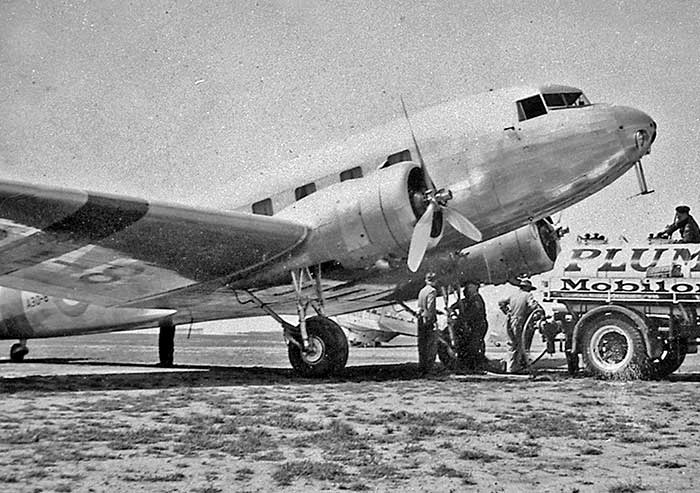
John Hopton Collection
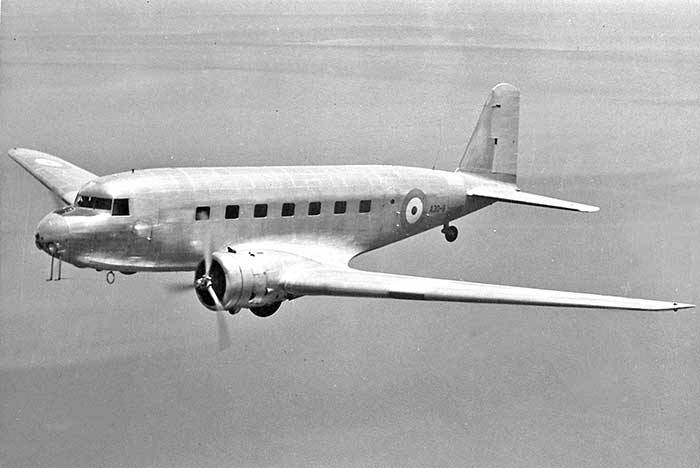
| .34 |
Built by Douglas Aircraft Co Inc at Santa Monica, California. Model DC-2-112 c/n 1292 |
| 12.34 |
Registered NC13782 Eastern Air Lines Inc, New York NY |
| Sold to Australian Government, shipped to Australia | |
| 3.2.41 |
Taken on RAAF charge as A30-9. Received ANA Essendon ex USA for assembly |
| 9.2.41 |
Received 1AD Laverton ex ANA |
| 24.3.41 |
Tailplane blown
against slope while taxying at RAAF Cressy in strong winds. Fin and
rudder damaged. Replaced with fin and rudder removed from A30-5 at Laverton. |
| 26.3.41 |
Received No.1 Wireless Air Gunner School, Ballarat ex 1AD |
| 13.2.42 |
Pilot log: Ballarat local flight,
F/Lt H.R.Beeston |
| 25.2.42 |
A30-9 departed Essendon for
Daly Waters NT flown by 1WAGS crew F/Sgt Frank Nolen and Warrant Officer
Alan Randall. Carried urgent medical supplies for the many military
personnel and civilians evacuated from Darwin to Daly Waters following
the first Japanese air raids on Darwin. |
| 9.3.42 |
Issued to 3WAGS
Maryborough ex 1WAGS |
| 18.5.42 |
Issued ANA Archerfield
for overhaul |
| 30.7.42 |
Received 2WAGS
Parkes ex ANA |
| 14.8.42 |
Received No.36
Squadron, Essendon ex 2WAGS. Squadron code "RE-K" |
| 8.42 |
Directorate of Air Transport Allied Air Forces issued radio callsign VHCRK which was painted on the aircraft |
| 8.11.42 |
Received 1AD Laverton
ex 36 Sqn for preparation for Parachute Training Unit |
| 20.11.42 |
Issued Parachute
Training Unit, Richmond ex 1AD |
| 24.6.43 |
Received ANA Mascot
ex PTU for overhaul prior to issue to 36 Sqn |
| 12.8.43 |
Received 36 Sqn
Essendon ex ANA Mascot. 36 Squadron's three remaining DC-2s had been replaced by C-47s on most transport duties. A squadron detachment was established at RAAF Richmondto operate the DC-2s for the Parachute Training Unit based there while still being available to 36 Squadron as required. This continued well into 1944. |
| 23.4.44 |
Received PTU Richmond
ex 37 Sqn |
| 14.12.44 |
Received 2AD Richond ex PTU
for storage |
| 15.11.45 |
Minister for Air approved free
issue of A30-9, -11, -12 & -14 to Department of Civil Aviation
for use by civil airlines |
| 16.1.46 |
Free issue declined by DCA.
The Department did not want DC-2s returning to post-war regular public
transport passenger operations when large stocks of disposals
C-47s were becoming available. A30-9 to be offered to Commonwealth Disposals Commission |
| Commonwealth
Disposals Commission document dated 8.5.46: "Department of Air has declared available four Douglas DC-2 aircraft and 13 Wright Cyclone engines, type GR.1820-F2B as fitted to DC-2 airframes. Approval is sought for (a) Treasury to be approached to make a free issue of two complete aircraft and two spare engines with associated propellors to the Council for Scientific and Industrial Research. (b) To sell by tender to the aviation industry the remaining and future arisings of aircraft and engines of this type. Department of Civil Aviation will grant a licence for these aircraft to operate on secondary routes only, i.e., intra-state journeys, until April, 1947, when the matter is to be reviewed and it is anticipated they will then be withdrawn from passenger operation. Overhaul and conversion for passenger use is estimated to cost £7,000. The matter was discussed with Group Captain Wiggins, DCA technical officer, who advised that his Department has been desirous of having tests carried out by C.S.I.R. in respect to fatigue in metal aircraft, more especially since metal fatigue was found to be the cause of the crash of a Stinson aircraft*. The two machines concerned, he stated, were admirable for the purpose having completed some 18,000 hours flying. The aircraft will not fly again but will be dissembled and each major section - stub wings, outer wings, tail unit, controls, etc., re-erected as though on an aircraft and will the be subjected to various tests. He stated that no authority throughout the world has yet given an opinion on the safe life of Metal Transport Aircraft.” * The Stinson aircraft was ANA Stinson A VH-UYY converted from trimotor to two 600hp P&W R-1340-S3H1 engines, which broke up in flight and crashed Redesdale Vic 31.1.45. |
|
| 25.7.46 |
A30-9 and A30-14 approved by
Treasury for free issue to Council
for Scientific and Industrial Research, Sydney NSW. |
| 20.8.46 |
2 Maintenance Group to pack and transport aircraft at no cost to CSIR |
| - |
Acquired from CSIR by Sid
Marshall, Marshall Airways, Bankstown Aerodrome NSW |
| 50s |
Transported to Bankstown. Stored
in Marshall Airways hangar, standing on its undercarriage with outer
wings removed |
| 7.3.65 |
DC-2s A30-9 and VH-CDZ were
towed on their wheels behind a truck from Bankstown to Camden Airport
where they were stored in a hangar leased by Aerial Agriculture Pty
Ltd. Sid Marshall had agreed to an Aerial Agriculture proposal to use half of his Bankstown hangar for their expanding business, requiring a number of his stored aircraft to be removed from his hangar. |
| c71 |
The Camden hangar was no longer
available. A30-9 and VH-CDZ were moved to a vacant block in the nearby
town Narellen where they were tempirarily parked together exposed
to the weather. |
| VH-CDZ was sold to an American
aviation enthusiast and moved from Narellan back to Bankstown Airport
for a planned flying restoration. |
|
| c78 |
A30-9 was moved from Narellan
to The Oaks airfield near Camden NSW where Sid Marshall's long-time
chief engineer and partner Jack Davidson was storing and selling Marshall
aircraft following Sid's death. The DC-2 was parked at The Oaks on its wheels with outer wings removed. |
| .82 |
Reports in British aviation
press reported that Aces High Ltd, London planned to restore A30-9
to airworthy for a 50th anniversary commemoration flight London-Melbourne
for Dutch National Television. |
| .82 |
A30-9 was sold to Jack
McDonald DC-2 syndicate, Melbourne. Jack was an airline pilot with IPEC Essendon and earlier Brain and Brown Airfreighters. He was warbird enthusiast, widely known from his 1960s airshow performances in his Mustang VH-FCB. The syndicate was formed by McDonald and aircraft engineer James Wright to restore A30-9 to airworthy for the planned 1984 commemoration flight London-Melbourne. |
| Late 82 |
Moved by road from The Oaks
to Essendon Airport, Melbourne. Significant restoration was carried
out in the IPEC hangar at Essendon Airport. Aircraft was complete
and painted as silver RAAF "A30-9" by 11.84 |
| c85 |
The restoration project ceased
despiute externally complete. Moved to IPEC hangar at Essendon where
stored. Noted in IPEC habgar 2.88 |
| .88 |
Moved from Essendon to Tyabb
Airfield Vic, parked in the open with outer wings removed. |
| 2005 |
Donated to Australian
National Aviation Museum, Moorabbin Airport Vic |
| Displayed at museum while under
restoration, painted as "KLM PH-AJU Uiver" |

John Hopton Collection
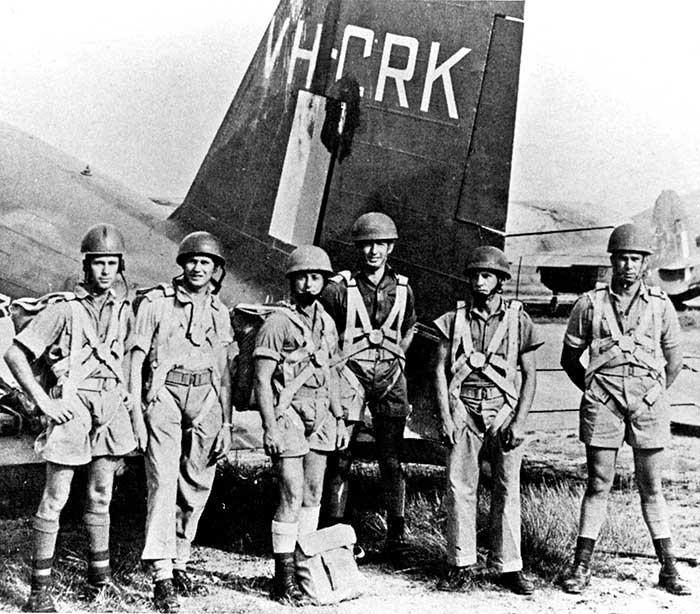
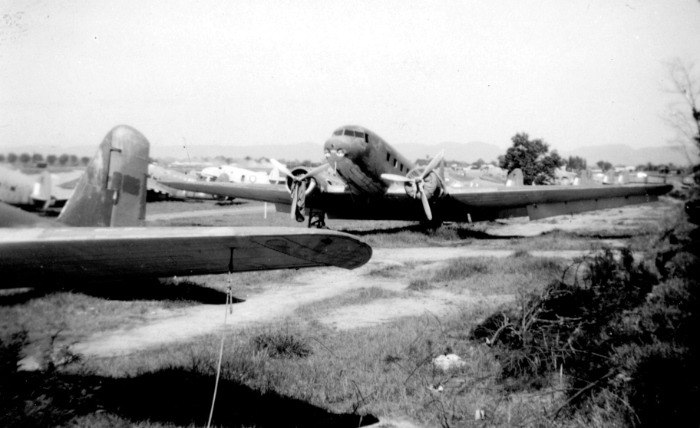
RAAF DC-2s A30-9 (front) and A30-14 with rows of retired Hudsons at RAAF Richmond circa 1946, awaiting postwar
disposal. These two were the only DC-2s listed for disposal from Richmond. David Vincent collection
disposal. These two were the only DC-2s listed for disposal from Richmond. David Vincent collection
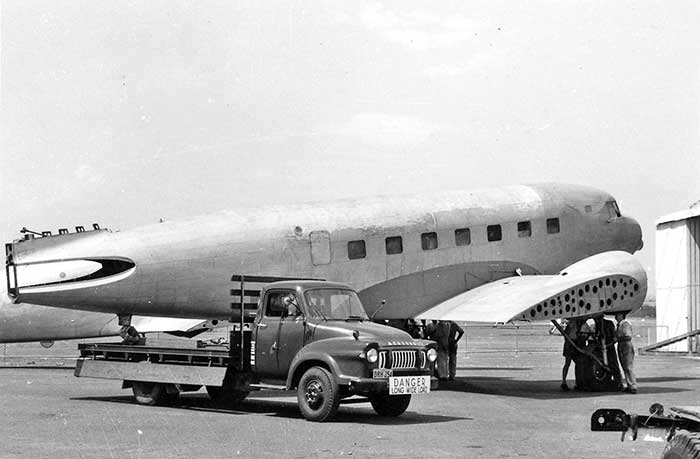
Photo by Peter Limon
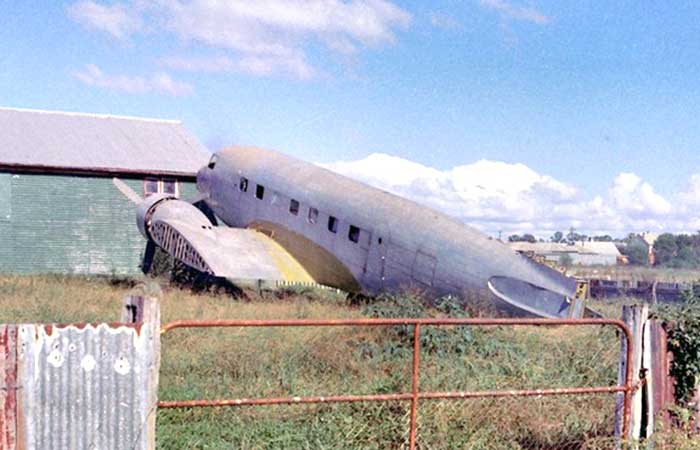
Photo circa 1975 by John Hopton
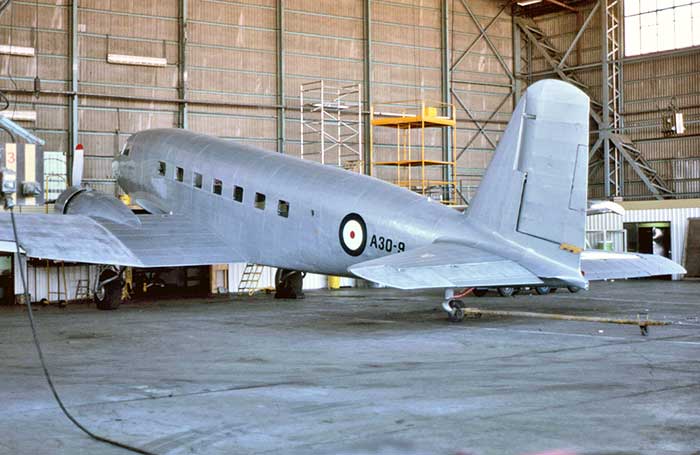
Photo by Geoff Goodall
| .35 |
Built by Douglas Aircraft Co Inc at Santa Monica, California. Model DC-2-171 c/n 1372 |
| 11.35 |
Registered NC14969 Eastern Air Lines Inc, New York NY |
| 15.11.35 |
Delivery date |
| Sold to Australian Government, shipped to Australia | |
| 3.41 |
Assembled
by Australian National Airways at Essendon Aerodrome, Melbourne |
| 17.3.41 |
Brought on RAAF
charge as A30-10. Received
No.1 Aircraft Depot Laverton ex ANA Essendon |
| 21.4.41 |
Issued to No.1
Wireless Air Gunner School, Ballarat ex 1AD to repoace A30-7 |
| 21.1.42 |
Pilot log: Essendon-Ballarat-Essendon,
P/O Peter J.Gibbes, F/O P.C.Burdue |
| 28.1.42 |
Issued to ANA
Essendon for conversion to transport aircraft. (This included installing a wide cargo door in the rear fuselage and a quick-assembly mobile crane for lifting heavy items like aircraft engines.) |
| 23.3.42 |
Received 1AD ex
ANA, issue to Northern Area same day. Collected at Essendon by F/Lt
Horrie Beeston and W/O Alan Randall during their posting from 1WAGS
to No.2 Communivcats Flight, Mascot. |
| For the next 5 weeks Beeston
and Randall flew extensive freight operations, carrying aircraft engines,
Hudson long range fuel tanks, radio equipment, glycol stocks. Evacuated
RAAF personnel from Broome WA following the Japanese air raid there
earlier in the month. Carried freshly killed beef from Nookenbah Station
to Port Hedland to feed the troops stationed there. Carried supplies from Melbourne to Daly Waters. At Daly Waters loaded Hudson spare parts (two engines, undercarriage and outer wing section) for a damaged Hudson grounded at Drysdale River Mission WA. Landed there after dark to avoid Japanese recce aircraftand departed at 4am carrying the damaged Hudson engines to Laverton. |
|
| 9.4.42 |
Departed Port
Pirie for Laverton |
| 13.4.42 |
Received 1AD Laverton
ex Pearce |
| 28.4.42 |
Allotted No.36 Squadron ex 1AD
. To take up transport duties in North West Area. |
| 1.5.42 |
Departed Port Pirie for Laverton |
| 6.5.42 |
After delivering
stores to Daly Waters, aircraft to return to Alice Springs to load
two engines for Hudson A16-208 and take them to Daly Waters |
| 26.5.42 |
Now with 36 Squadron
based Laverton operating to North West Area |
| 5.42 |
Directorate of Air Transport Allied Air Forces issued radio callsign VHCRD which was painted on the aircraft |
| 13.6.42 |
Departed Mildura
for Daly Waters |
| 18.6.42 |
At Laverton being
serviced |
| 23.6.42 |
enroute Batchelor
to Laverton |
| 24.6.42 |
Nhill-Laverton |
| 6.42 |
36 Squadron DC-2s A30-10 &
A30-13 were flying shuttles from Daly Waters to Batchelor carrying
300lb bombs for USAAF B-17s bombing Japanese airfields in Sulewesi
and Timor. The DC-2s carried 8 bombs tied to lugs on cabin floor each
flight, the detonators stowed in the cockpit. 5 return flights each
day. |
| 7.42 |
36 Squadron relocated from RAAF
Laverton to RAAF Essendon. Major overhauls and engine changes contracted
to ANA Essendon. |
| 14.11.42 |
A30-10 departed Essendon for
Townsville carrying a ton and a half of freight, flown by F/O J.L.D."Wac"
Whiteman and P/O Frank.J.Ball. Arrived Townsville the following day
|
| 17.11.42 |
Townsville-Cooktown-Iron Range-Horn
Island carrying supplies to an American unit at Red Island Point,
returning to Townsville 20.11.42. Same crew |
| 21.11.42 |
Departed Townsville for Rockhampton-Archerfield-Mascot-Essendon.
Same crew. Acid had been spilt on the cabin floor and down into the
airframe and control cables. Both engines were performing badly and
were close to maximum time before overhaul. Whiteman refused to load
cargo due to the aircraft's poor condition. ANA checked the engines
at Archerfield and Whiteman had made 5 test flights, but engines continued
to run roughly, so Whiteman followed the coastline for the rest of
the flight to allow for engine failure. Overnight at Mascot where ANA did further work on the engines. |
| 23.11.42 |
Late departure Mascot for Essendon
due engine work, same crew. Flight planned coastal due the engines
and poor weather on the direct inland route. Approaching Mallacoota
in poor weather and the engines still running roughly, Whiteman landed
for the night. |
| 24.11.42 |
Departed Mallacoota for Essendon
but returned due rough running engines and bad weather enroute. Whiteman was ordered to proceed to Essendon |
| 24.11.42 |
Crashed
on takeoff Mallacoota Vic.
Pilot F/O J.L.D.Whiteman, P/O F.J.Ball and four airmen all injured. Port engine ran rough as the aircraft became airborne then burst into flames. Unable to climb over tall timber ahead Whiteman made a hard turn digging the port wing into the ground, the aircraft skidded on its belly and coming to a stop facing back down the runway. (For a detailed description of this event and its aftermath see the book There And Back by Allan Randall) |
| 6.1.43 |
Issued to ANA Essendon |
| 10.2.43 |
Received 1AD ex ANA for conversion
to components |
| 12.8.43 |
Allotted
to Royal Australian Engineers Training Centre, Wagga NSW as a training
aid |
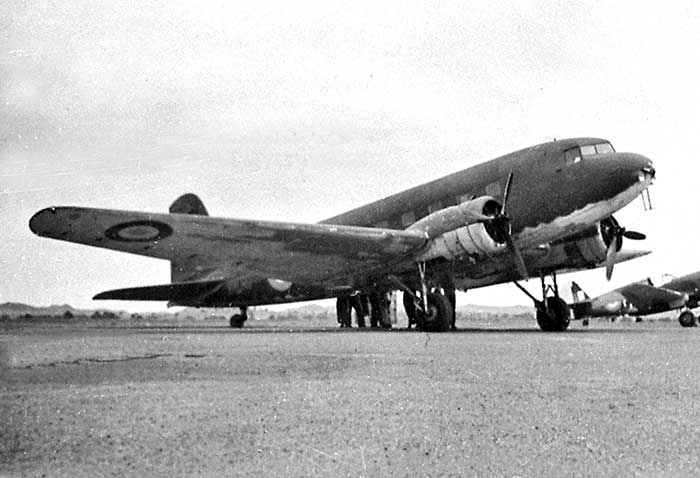
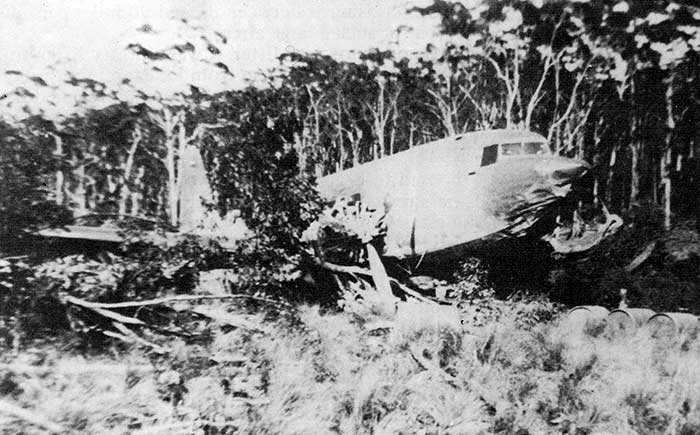
| .34 |
Built by Douglas Aircraft Co Inc at Santa Monica, California. Model DC-2-112 c/n 1286 |
| 11.34 |
Registered NC13736 Eastern Air Lines Inc, New York NY |
| Sold to Australian Government, shipped to Australia | |
| Assembled by Australian National Airways at Essendon Aerodrome, Melbourne | |
| 30.3.41 |
Brought on RAAF charge as A30-11. Received No.1 Aircraft Depot Laverton ex ANA Essendon |
| 24.4.41 |
Issued to No.1
Service Flying Training School Signals School, Point Cook ex 1AD |
| 30.1.42 |
Received No.1 Wireless Air Gunner
School, Ballarat ex 1SFTS |
| 9.2.42 |
Received 1SFTS Signals School
Point Cook ex 1WAGS |
| 5.4.42 |
Received 1AD Laverton
ex 1SFTS for overhaul |
| 13.4.42 |
Received No.36 Squadron Laverton ex 1AD. Squadron code "RE-B" |
| 24.4.42 |
Issued to ANA
Essendon for conversion to transport aircraft. (This included installing a wide cargo door in the rear fuselage and a quick-assembly mobile crane for lifting heavy items like aircraft engines.) |
| 8.6.42 |
Allotted 36 Sqn
ex ANA |
| 6.42 |
Directorate of Air Transport Allied Air Forces issued radio callsign VHCRE which was painted on the aircraft |
| 13.6.42 |
Aircraft at Richmond |
| 17.6.42 |
Enroute Batchelor-Laverton |
| 26.6.42 |
To proceed immediately
to North West Area. To load P&W SC3G engines at 5AD Wagga for
Pearce |
| 4.7.42 |
Enroute to Perth |
| 7.42 |
A30-11 crewed by pilots F/O
Doug Barker and W/O Alan Randall, wireless operator Sgt Maloney and
fitter Ernie Flack departed Laverton for Archerfield via overnight
stop Canberra. Carried personnel to Richmond. Then 4 return trips
Bankstown-Batchelor via refuelling stops at Narromine, Charleville,
Cloncurry and Daly Waters each direction, delivering the components
of a complete radar station to be erected at Melville Island. Stranded at Daly Waters for 9 days when an engine failure required a replacement to be flown in. |
| 7.42 |
36 Squadron relocated from RAAF
Laverton to RAAF Essendon. Major overhauls and engine changes contracted
to ANA Essendon and Ansett Airways Essedon. |
| 18.11.42 |
Minor taxying
damage, struck a stationary B-25 Mitchell. No
location mentioned on RAAF record card |
| 11.42 |
36 Squadron relocated from Essendon
to Townsville. A30-11 remained at Essendon with a small rear echelon
to complete tasks |
| 20.12.42 |
A30-11 at Essendon commenced
a two month operation to transport aircraft engines to the Darwin
area after overhaul by RAAF workshops at Tocumwal, Wagga and Richmond.
On the return flight u/s engines were brought back for overhaul. Two
36 Sqn crews were allocated, under Captains F/O Lionel Van Praag and
W/O Alan Randall. Operation completed 7.2.43. Randall's crew had flown
183 hours. |
| 6.43 |
36 Squadron's three remaining
DC-2s had been replaced by C-47s on most transport duties. A squadron
detachment was established at RAAF Richmondto operate the DC-2s for
the Parachute Training Unit based there while still being available
to 36 Squadron as required. This continued well into 1944. |
| 26.4.44 |
Received ANA Essendon ex 36
Sqn for rigging check and maintenance |
| 13.6.44 |
Received 7AD Tocumwal ex ANA
Essendon for maintenance. |
| 18.7.44 |
Received ANA Parafield ex 7AD
for completion of work. |
| 2.12.44 |
Received 34 Squadron, Parafield
ex ANA Parafield. 34 Sqn had transport detachments at Townsville Qld
and Coomalie Creek NT. |
| 2.3.45 |
Issued to 37 Squadron, Essendon
ex 34 Sqn. Now all metallic finish with VHCRE on tail in black |
| 2.3.45 |
Substantial
damage forced landing at Parafield due port engine failure.
Departing on ferry flight to 37 Sqn. Damage to fuselage, starboard wing and undercarriage. Flt Lt W. O. Thomas (37 Sqn), 3 crew and 12 passengers unhurt. |
| 5.3.45 |
Allotted No.5 Central Recovery
Depot, Port Pirie. Not collected |
| 10.8.45 |
Recommended for disposal by
Commonwealth Disposals Commission |
| 15.11.45 |
Minister for Air approved free issue of A30-9, -12 & -14 to Department of Civil Aviation for use by civil airlines |
| 16.1.46 |
Free issue declined by DCA.
The Department did not want DC-2s returning to post-war regular public
transport passenger operations when large stocks of disposals
C-47s were becoming available. A30-11 to be offered to Commonwealth Disposals Commission |
| 14.8.46 |
Commonwealth Disposals Commission
aircraft tender list issued. These regular lists invited tenders for
aircraft, engines and equipment. This document included Catalinas,
Walrus, Seagull, DC-2s, Percival Q6, Stinson Reliant and engines.
The DC-2s were quoted as: - A30-12 held by 37 Squadron, Essendon: very poor condition, with engines - A30-11 held by Care & Maintenance Unit, Port Pirie but actually located at Parafield. Airframe only. - 9 spare Wright Cyclone GR-1820-F2B engines and a considerable listing of spares for the engine type |
| 3.10.46 |
A30-11 airframe only sold by
Commonwealth Disposals Commission for £52 to Marshall
Airways, Mascot Aerodrome, Sydney NSW |
| 27.11.46 |
Collected by purchaser |
| 11.46 |
Sid Marshall, founder of Marshall Airways arranged for A30-11 to be moved to a farm close to Parafield aerodrome on the access road close to Main North Road. He had purchased A30-11 as a parts source only, to provide components for the other RAAF DC-2s he had acquired for a planned NSW internal airline that never eventuated. |
| 3.7.51 |
Parafield Aerodrome report by John M. Smith: "First aircraft sighted was on the road leading into the aerodrome, in a paddock just off the airfield boundary was Douglas DC-2 A30-11. It was standing on its undercarriage but outer wings removed. It was overall metallic, and carried the radio callsign VHCRE on the tail. Still discernable over the windows was the legend "The Great Silver Fleet" from its days with Eastern Airlines in USA." |
| Late 54 |
Sid Marshall and his chief engineer
Jack Davidson drove from Sydney to Adelaide in Sid's Chevrolet truck
to collect A30-11. They rigged the airframe to be towed backwards
on its own wheels and towed the fuselage back to Bankstown. Meanwhile Sid had learned from Charles M. McDonald (who had operated in 1947 as Macair Charter Service, Sydney with a DC-2 and C-39 VH-ARC on migrant charters to Europe) that he had a DC-2 mainplane centre-section stored in Adelaide. McDonald had purchased it from Commonwealth Disposals Commission and left it in Adelaide. Sid purchased this centre-section with the plan to eventually use it to replace the accident-damaged centre-section of A30-11. Sid and Jack returned to Adelaide in the Chevrolet truck to collect A30-11's two wings from the farm and the spare centre-section. While driving out of Adelaide up the long incline of Glen Osmond Road, the load proved too heavy for the truck. Sid arranged with a Mobil petrol station on the road to allow him to unload the DC-2 centre-section and leave it at the rear of the garage workshop. There it remained for the next 12 years. Despite Sid paying a storage fee for many years, during 1966 the garage proprietor sold it as scrap metal and sent Sid a letter afterwards. Marshall was very annoyed because the centre section had the full undercarriage mechanism and fittings. |
| A30-11 was left dismantled in
the open weather in the Marshall Airways storage compound on the boundary
at Bankstown Airport. Other Marshall Airways aircraft in the compound
in the 1960s were two other DC-2s, retired Avro Ansons, a Spitfire
and Nakajima Oscar, also a Sydney double-decker bus. |
|
| 17.3.65 |
Marshall Airways DC-2s VH-CDZ
and A30-9 were removed from the Bankstown hangar and moved to a hangar
at Camden as part of Sid Marshall leasing half of his hangar to Aerial
Agriculture Pty Ltd. Seen during the hangar clean-out was the fuselage
of Widgeon VH-UGI and tail fin of A30-11 marked "VHCRE" with US registration
NC13736 discernable etched in the metal. |
| .79 |
A30-11 was acquired from Sid
Marshall's Estate by Rotary
Club of West Albury. The Club planned a memorial to the city's role in helping KLM's PH-AJU during the 1934 London-Melbourne Air Race, when it made a forced landing at night on Albury Racecours on the final leg into Melbourne. |
| 31.8.79 |
Moved by road from Sydney to
Albury. Restored in a hangar at Albury Airport and painted as "KLM PH-AJU Uiver". |
| 28.1.80 |
The memorial at Albury Airport
was unveiled with the DC-2 mounted on poles. |
| 29.8.02 |
DC-2 removed from the pole display in a 6 hour operation, lifted over airport fence and parked on its undercarriage near hangars, pending a decision on its future. The Airport Manager stated that reason was airframe corrosion concerns could make the memorial unsafe. An airport engineering firm would make an assessment of repairs needed. The Dutch Government had provided funds for the restoration but council expected the cost to be much higher. |
| Debate over public funds being
used to save the DC-2 became an embarrassment to the Albury Council. |
|
| .09 |
Albury Council offered the DC-2 for disposal. Bids were made by museums and interested parties but the council then bowed to local criticism and decided to retain the aircraft, pending a decision on its fate. |
| Parked at Albury Airport |
|
| .14 |
Sold to the Uiver
Memorial Community Trust, Albury NSW : www.uivermemorial.org.au |
| Currently
under restoration at Albury |
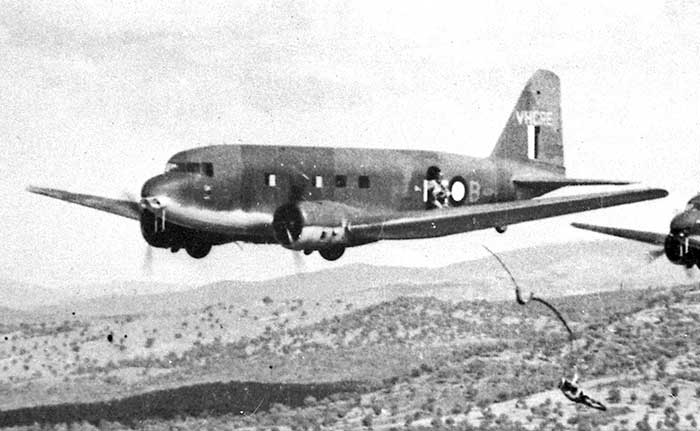
John Hopton Collection
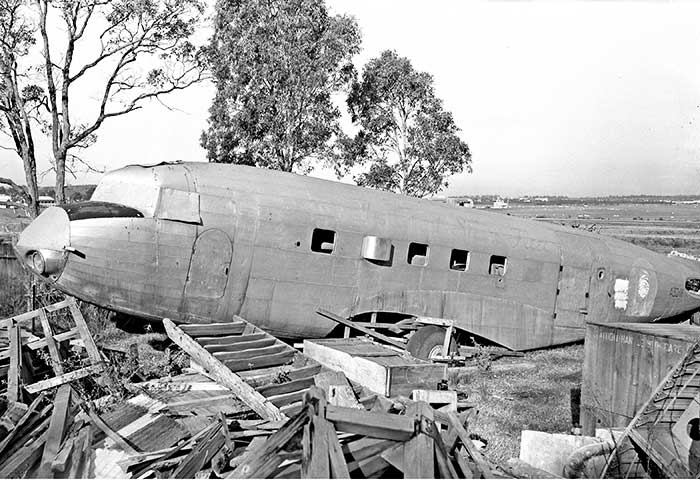
This and the following photo taken by John Hopton in May 1962.

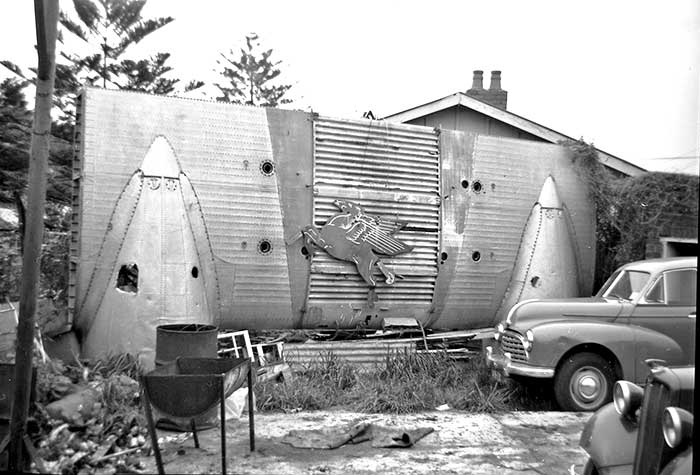
Meanwhile
A30-11's mainplane centre-section remained at an Adelaide motor garage
where it had been unloaded
by Sid Marshall in 1956. Pictured in June 1966, just prior to being sold for scrap metal. Photo by Geoff Goodall
by Sid Marshall in 1956. Pictured in June 1966, just prior to being sold for scrap metal. Photo by Geoff Goodall
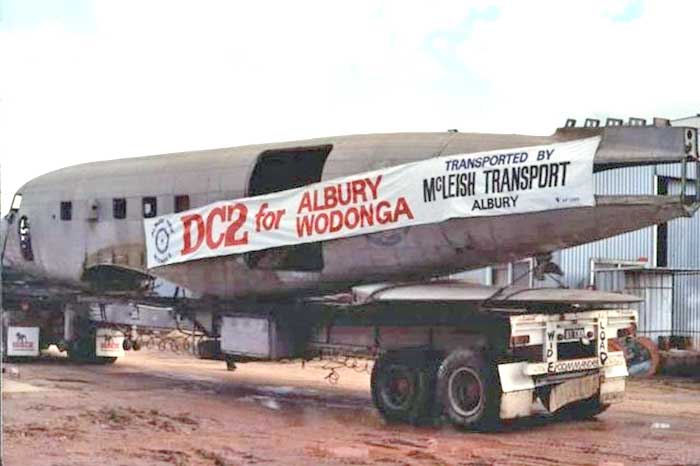

Photo in June 1994 by Geoff Goodall

| .34 |
Built by Douglas Aircraft Co Inc at Santa Monica, California. Model DC-2-112 c/n 1257 |
| 9.34 |
Registered NC13731 General Air Lines Inc, New York NY |
| 27.9.34 |
Delivered to General
Air Lines painted in GAL scheme |
| 15.12.34 |
General
Air Lines reformed as Eastern
Air Lines Inc, New York NY |
| Sold to Australian Government, shipped to Australia | |
| Assembled by Australian National Airways at Essendon Aerodrome, Melbourne | |
| 31.3.41 |
Brought on RAAF charge as A30-12. Received No.1 Aircraft Depot Laverton ex ANA Essendon |
| 17.6.41 |
Issued to No.1
Communications Flight |
| 30.9.41 |
Cockpit and forward
cabin seriously damaged by fire at Archerfield, Brisbane |
| 12.10.41 |
Issued to Australian
National Airways, Archerfield for repair. Progress was slow while
waiting for parts from USA and later ANA staff were diverted for maintenance
on USAAC aircraft |
| 30.3.42 |
Delivered to 1AD
Laverton ex ANA Archerfield |
| 28.4.42 |
Allotted No.36
Squadron, Laverton ex 1AD. |
| 4.42 |
Directorate of Air Transport Allied Air Forces issued radio callsign VHCRF which was painted on the aircraft |
| 9.42 |
Damaged
at Iron Range airfield, Cape York Qld. Requires replacement
starboard mainplane |
| 19.9.42 |
Starboard wing of A30-14 damaged
at Cooktown to be removed and transported to Iron Range for A30-12.
To be assembled on site at Iron Range with the help of the Americans and their equipment. |
| Refer A30-14 below for description of moving A30-14's starboard wing from Cooktown |
|
| 28.9.42 |
Received
No.12 Repair and Salvage Unit, Garbutt. Ferry flight from Iron Range
after replacement of starboard wing and temporary repairs. Full
inspection at 12RSU workshops at RAAF Garbutt |
| 12.10.42 |
Received 36 Sqn
ex 12RSU. 36 Sqn now based at Stock Route Strip, near Townsville. Squadron code "RE-A", callsign "VHCRF" on tail, name "Silk Merchant" painted under the cockpit |
| 18.10.42 |
Allotted ANA Essendon ex 36
Sqn. Received back at 36 Sqn 21.10.42 |
| 31.10.42 |
Pilot log: A30-12 Essendon-Wagga-Narromine-Archerfield-Townsville. Captain W/O Alan Randall, copilot Sgt Langley, W/T operator Sgt Mahoney, fitter LAC Ernie Cobb. |
| 11.42 |
Replacement mainplanes installed
by 12RSU Garbutt |
| 20.11.42 |
Pilot log: A30-12 Essendon-Wagga-Narromine-Archerfield-Rockhampton-Townsville.
Captain W/O Alan Randall, copilot F/Lt John Hyde, wireless operator Sgt Dick McKay, fitter ACI Koch. arrived Townsville after dark after flashing code letter of the day to the Magnetic Island gunnery unit by morse code. Flying time 10.5 flyting hours. No accommodation at Townsville so crew slept on aircraft. |
| 21.11.42 |
Pilot log: A30-12 same crew.
Planned Townsville-Essendon but USAAF transport officer gave them
orders to proceed to Port Moresbyand had cargo loaded for Cooktown
and Iron Range |
| 22.11.42 |
Pilot log: A30-12 same crew.
Iron Range-Horne Island-Port Moresby landed Wards Strip. |
| 23.11.42 |
Pilot log: A30-12 same crew.
Port Moresby-Townsville 4.30am departure: aborted takeoff in dark
to avoid a disabled aircraft on edge of runway, damaging port wheel
brakes. After repair departed 10.30am, landing at Cooktown and
Cairns enroute. Grounded at Townsville for repairs until 29.11.42 |
| 29.11.42 |
Pilot log: A30-12 same crew:
Townsville-Coen-Iron Range-Townsville |
| 30.11.42 |
Pilot log: A30-12 same crew:
Townsville-Jacky Jacky (Higgins Field/Bamaga)-Cairns |
| 1.12.42 |
Pilot log: A30-12 same crew:
Cairns-Townsville |
| 2.12.42 |
Pilot log: A30-12 same crew:
Townsville-Iron Range-Townsville. Landing Townsville in strong crosswind,
tail swung violently causing the tailwheel assembly to collapse and
minor damage to rear fuselage. Aircraft grounded Townsville 14 days while repairs carried out. |
| 4.6.43 |
Received Parachute Training
Unit, Richmond ex 36 Sqn |
| 14.7.43 |
Received 36 Sqn ex PTU. 36 Squadron's three remaining DC-2s had been replaced by C-47s on most transport duties. A squadron detachment was established at RAAF Richmondto operate the DC-2s for the Parachute Training Unit based there while still being available to 36 Squadron as required. This continued well into 1944. |
| 23.4.44 |
Received PTU Richmond ex 36
Sqn |
| 11.5.44 |
Ground-loop on takeoff due wind
gust, significent damage to airframe |
| 15.5.44 |
Issued to No.2 Central Recovery
Depot, Richmond |
| 20.5.44 |
Received 2AD Richmond for repair.
Airframe flying time 7,903 hours |
| 9.3.45 |
Received No.37 Squadron, Essendon
ex 2AD on completion of rebuild. 37 Sqn operated transport courier services throughout Australia, New Guinea, and to Morotai |
| 10.8.45 |
Recommended for disposal. Parked
at Essendon |
| 15.11.45 |
Minister for Air approved free issue of A30-9, -11, -12 & -14 to Department of Civil Aviation for use by civil airlines |
| 16.1.46 |
Free issue declined by DCA.
The Department did not want DC-2s returning to regular public transport
passenger operations when large stocks of disposals C-47s were becoming
available. A30-12 to be offered to Commonwealth Disposals Commission |
| 31.7.46 |
To be transferred to DCA Office
in Charge, Essendon Aerodrome pending disposal |
| 14.8.46 |
Tender document issued by Commonwealth
Disposals Commission for sale of Catalinas, Walrus, Seagull, DC-2,
Percival Q6, Stinson Reliant and aircraft engines. The two DC-2s were: - A30-12 held by 37 Squadron, Essendon: very poor condition, with engines - A30-11 held by Care & Maintenance Unit, Port Pirie but actually located at Parafield. Airframe only. Poor condition. Instruments and electrical equipment sealed and stored for protection - Nine spare Wright Cyclone GR-1820-F2B engines and a considerable listing of spares for the type |
| 4.10.46 |
Sold by Commonwealth Disposals
Commission for £225 to Marshall
Airways. Mascot Aerodrome, Sydney |
| 22.11.46 |
Issued to purchaser ex DCA Essendon |
| No
further reports found for this aircraft. Assumed broken up at Essendon
for engines and parts for Sid Marshall's other RAAF disposals DC-2
purchases. |
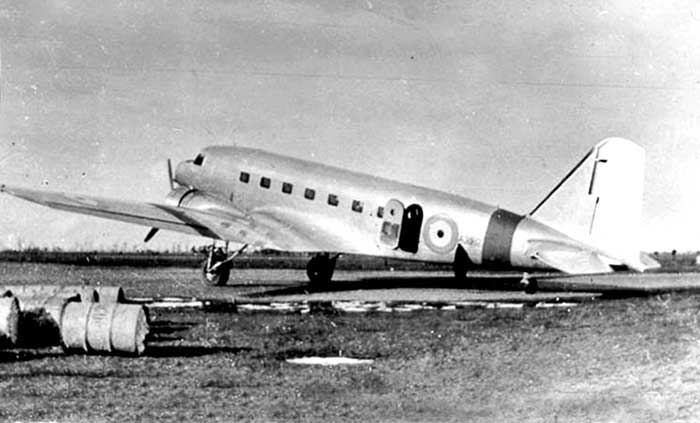
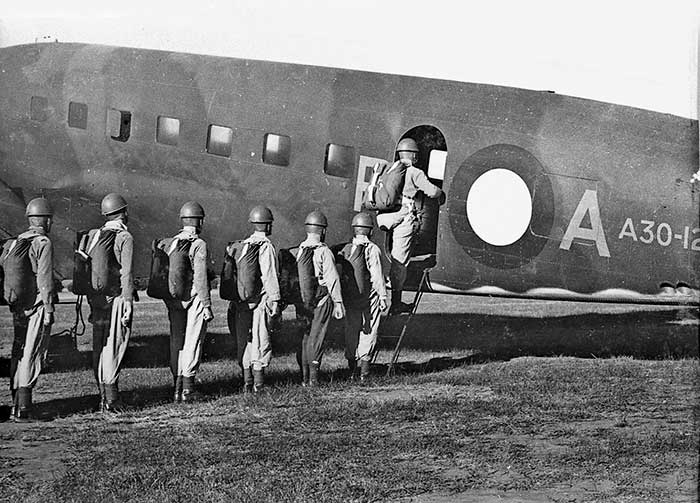
Photos: John Hopton Collection
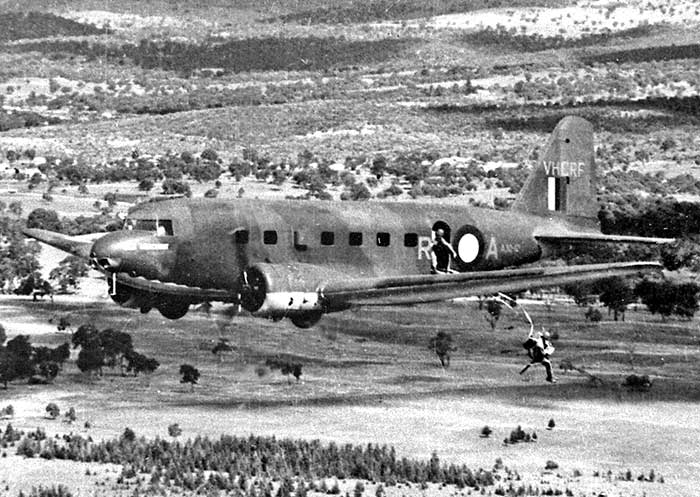
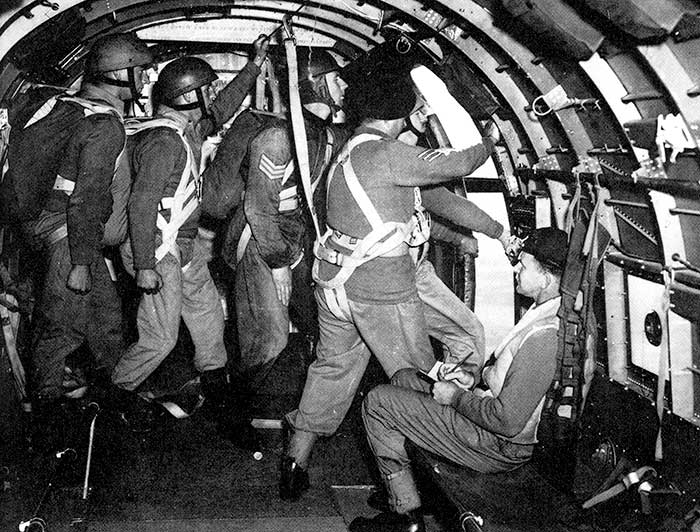
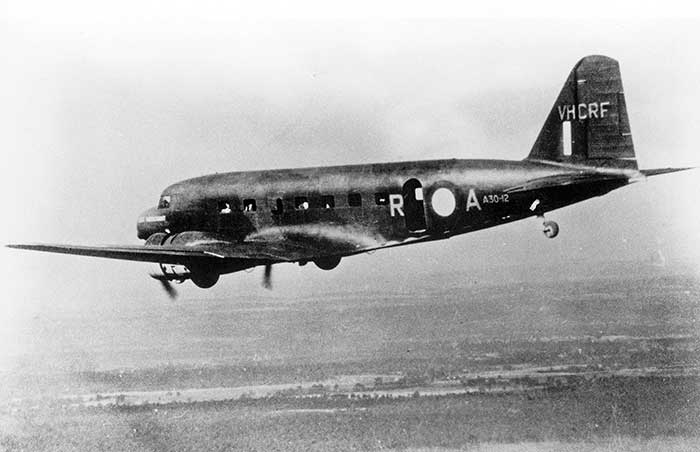
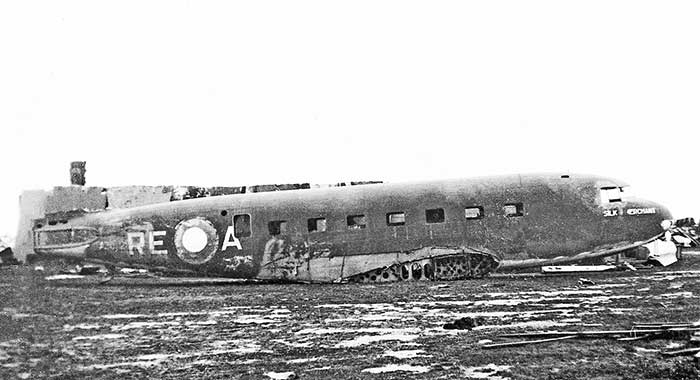
| .35 |
Built by Douglas Aircraft Co Inc at Santa Monica, California. Model DC-2-171 c/n 1373 |
| 12.35 |
Registered NC14970 Eastern Air Lines Inc, New York NY |
| 6.12.35 |
Delivered to Eastern
Airlines |
| Sold to Australian Government, shipped to Australia | |
| Assembled by Australian National Airways at Essendon Aerodrome, Melbourne | |
| 27.4.41 |
Taken in RAAF
charge as A30-13. Received
1AD Laverton ex ANA Essendon |
| 27.6.41 |
Received No.2
Wireless Air Gunners School, Parkes ex 1AD |
| 3.2.42 |
Departed Richmond
carrying wireless equipment to Darwin |
| 11.2.42 |
Received 1AD ex
Darwin for engine change |
| 25.2.42 |
Issued 2WAGS Parkes
ex 1AD |
| 21.3.42 |
Received 1AD ex
Northern Area |
| 31.3.42 |
Departed Richmond
for Daly Waters |
| 13.4.42 |
Issued ANA Essendon
ex 1AD for overhaul |
| 29.4.42 |
Received No.36
Squadron, Laverton ex ANA Essendon via Daly Waters |
| 4.42 |
Directorate of Air Transport
Allied Air Forces issued radio callsign VHCRG
which was painted on the aircraft |
| 17.6.42 |
Between Laverton
and Mareeba on return trip |
| 6.42 |
36 Squadron DC-2s A30-10 &
A30-13 were flying shuttles from Daly Waters to Batchelor carrying
300lb bombs for USAAF B-17s bombing Japanese airfields in Sulewesi
and Timor. The DC-2s carried 8 bombs tied to lugs on cabin floor each
flight, the detonators stowed in the cockpit. 5 returnflights each
day. |
| 27.6.42 |
A30-13 pilots F/O Doug Barker
and W/O Alan Randal, Wireless Operator Don Tremble and Fitter Norm
Parker departed Laverton to join the Daly Waters bomb shuttles. Overnighted
Alice Springs |
| 29.6.42 |
A30-13 commenced Daly Waters-Batchelor
shuttles, 5 return trips each day carrying bombs. Some flights were
delayed due Batchelor air raid warnings. |
| 1.7.42 |
A30-13 departed
Daly Waters to return to Laverton, arrived back 2.7.42 |
| 1.8.42 |
Returning to Archerfield damaged
|
| 3.8.42 |
Issued No.10 Repair and Salvage
Unit, Amberley ex 36 Sqn for repairs |
| 4.9.42 |
Received 36 Sqn, Stock Yard
Strip Townsville ex 10RSU |
| 8.1.43 |
Crashed
landing Cooktown Qld. Pilots F/O Bert Starkey and P/O Gerry
Unkles, A.J.Stribely (Wireless Op), J.R. Haugh (fitter). Pilot attempted a late go-around, stalled, starboard wing contacted the runway, aircraft violently ground-looped off the runway. 10 personnel on board minor injuries. Aircraft was carrying two 36 Sqn crews to Port Moresby to carry out supply dropping in New Guinea flying USAAF aircraft. |
| 36 Squadron fitter Alan Picton
was on board. He later wrote of this accident: "There was only one strip at Cooktown and due to its proximity to the Endeavour River, the prevailing wind was all crosswind. At that time the Allied Works Council were laying pipes to improve the drainage and there was a line of 3 feet diameter pipes on the ground along one side of the strip. During our approach there was a crosswind of about 20 knots and the aircraft started to drift towards the pipes. Bert Starkey called for full power and wheels up, intending to make a go-around, but the aircraft stalled at about 100 feet, starboard wing dropped and in she went. The Allied Works Council blokes were on the scene immediately but it took quite a bit of effort to get the door open. We all piled out but realised Gerry Unkles wasn't with us. A couple of us went back in and found that Gerry had a foot jammed under the rudder pedal and it was only after much pulling and pushing that we got him free. As we left the aircraft, the port engine, which had broken away from the wing began to burn but the fire was quickly extinguished. We were taken toa RAAF camp between the strip and the town. A few days later our supply-dropping crews continued their journey to Port Moresby, this time on A30-12." Gerry Unkles recalled: "Although my leg was damaged, I walked a good 50 yards from the aircraft before I found I could walk no further. I sat down on a pile of earth and took off my boot and sock. A big civilian construction worker picked me up as if I was a child and carried me gently to a vehicle in which I was driven to Cooktown hospital. There a couple of very pleasant American doctors initiated me to the anaesthetic delights of sodium pentathal and pulled bits of me into place. After a couple of days I returned to Townsville in another DC-2 flown by Nick Guthrie." |
|
| 14.1.43 |
Received No.12 Repair and Salvage
Unit, Garbut Field Townsville for salvaging on site |
| 21.4.43 |
Allotted 1AD Laverton ex 12RSU
for assessment of repair required |
| 27.4.43 |
Shipped on "Bidelia" via Cairns |
| 2.7.43 |
Allotted to ANA Essendon |
| 10.8.43 |
Allotted 1AD ex ANA Essendon
for conversion to components.
Repairable items to be issued to ANA |
| .34 |
Built by Douglas Aircraft Co Inc at Santa Monica, California. Model DC-2-112 c/n 1288 |
| 10.34 |
Registered NC13738 General Air Lines Inc, New York NY |
| 15.12.34 |
General Air Lines reformed as Eastern Air Lines Inc, New York NY |
| Sold to Australian Government, shipped to Australia | |
| Assembled by Australian National Airways at Essendon Aerodrome, Melbourne | |
| 1.5.41 |
Taken on RAAF
charge as A30-14. |
| 9.5.41 |
Received No.1 Aircraft Depot Laverton ex ANA Essendon |
| 25.1.42 |
Received No.1
Communications Flight, Laverton ex 1AD |
| 5.2.42 |
To arrive Richmond
to carry wireless equipment to Darwin |
| 3.42 |
Issued No.36 Squadron,
Laverton ex 1CF via 1AD |
| 22.3.42 |
A30-14 was the first aircraft
for the newly-formed No.36 (Transport) Squadron which continues to
operate in that role today. 36 Sqn commenced operations effective
22.3.42 at Laverton with A30-14 as its only aircraft, personnel of
2 officers and 24 other ranks under CO Ft.Lt W.P.Heath. Initial squadron
headquarters were two rooms made out of packing crates next to the
Duty Pilots Tower. A30-9, -10, -12 and -13 were allotted to 36 Sqn over the next two months. |
| 11.4.42 |
Arrived Oodnadatta
SA |
| 18.4.42 |
Departed Parafield
for Laverton |
| Directorate of Air Transport Allied Air Forces issued radio callsign VHCRH which was painted on the aircraft | |
| 12.9.42 |
Accident
at Cooktown Qld, extensive damage. Airframe total time 16,665
hrs, RAAF flying time 766 hrs. 19.9.42: starboard wing of A30-14 to be removed and sent to Iron Range Qld to repair damaged A30-9. |
| 28.9.42 |
Allocated No.12
Repair and Salvage Unit, RAAF Charters Towers for damage assessment. |
| George McBride, then a young fitter with 12RSU later wrote of his experiences with this DC-2: "I was on assignment at Garbutt (Townsville) with my small group from 12RSU working on the around-the-clock assembly of Kittyhawk fighters urgently needed as replacements for losses at Milne Bay. I received a call from my Engineering Officer instructing me to take my salvage crew to attend to crashes at Cairns, Cooktown and Iron Range. The one at Cairns was a Beaufort with landing gear problem which was quickly addressed. On to Cooktown where a RAAF DC-2 and two C-47s had come to grief in the mud surrounding the short Mission Strip on the outskirts of town. On our arrival at Cooktown, our RAAF C-47 made a very heavy landing, resulting in the top engine mount bolts shearing on one engine, which dropped and the propeller destroyed the tyre. Fortunately there were the two damaged C-47s at the airstrip, so we soon had ours serviceable and on its way. We now dismantled the two damaged C-47s and DC-2 and moved them to the Cooktown jetty, to be picked up by ship. We had to use whatever we could lay our hands on to move the aircraft around - bomb trolleys, borrowed tractors and rail wagons were pressed into service. We received word that a RAAF DC-2 at Iron Range had a badly damaged wing and we were to send the wing from the DC-2 at Cooktown. This created a major problem, solved when a large Samoan cutter sailed into Cooktown harbour on its way to New Guinea for coast watch duties. We talked to the skipper who agreed that if we could load the wing on his boat, he would take us to Portland Roads which was the port for Iron Range.We duly loaded the wing and tied it to the mast and off we went, sailing during the day dodging reefs and anchoring at night. We arrived at the cluttered Portland Roads jetty, which was the supply lifeline to the Iron Range USAAF base. A friendly US Liberty ships crane operator lifted the wing and dropped it gently on the jetty. We borrowed a US Army Blitz truck to take it to the airfield. With the help of local aborigines we removed the damaged wing and fitted the replacement." |
|
| 16.11.42 |
Dismantled by 12RSU
waiting for shipping to Melbourne to ANA for rebuild |
| 12.1.43 |
Shipped ex Cooktown
by vessel Poonbar to Cairns
where will be transferred to ship Ormiston
for Sydney |
| 8.2.43 |
To be shipped on Corio
leaving approximately 13 February |
| 13.2.43 |
Missed Corio,
loaded on Liberty Ship J.G.Fields |
| 19.2.43 |
Forwarded to ANA Essendon on SS Cardross for rebuild to freighter standard: interior lining removed, stronger floor installed and attachment points for limited removeable seating. A large cargo door was installed. |
| 7.10.43 |
On completion of repair by ANA,
allotted on temporary loan to Department
of Civil Aviation for civil airline use. To be returned
to RAAF when ANA completes repair of A30-6 anticipated in late November
1943. |
| 12.10.43 |
Application for CofR and CofA
submitted by ANA |
| 13.10.43 |
Handed over to DCA at Essendon
and issued to ANA Essendon |
| 13.10.43 |
Registered VH-CRH:
Commonwealth
of Australia, on loan to Australian National Airways Ltd CofA issued. DCA also issued an Authority to Operate on this date. Compiler's note: DCA's issue of CofR and CofA using its military callsign as a civil Registration was highly unusual, probably because of the haste in negotiating the release of this military aircraft on loan to an airline. An indication of internal departmental concern is given by the CofR and CofA documents being prepared and validated on 13 October, but not signed for six weeks, until 26 November 1943, after the loan period was extended. It appears likely that the original intent was to hold off signing the Certificates for the initial short loan period, covered by the Authority to Operate - to avoid formalising the certificates. None of this bureaucratic paper shuffling had any effect on ANA's use of the DC-2 which proved essential to ANA maintaining passenger services for 4 months. |
| 13.10.43 |
Pilot log: VH-CRH MEL-SYD-BNE-SYD-MEL,
ANA Captain J. Kemp, FO Charles D. Pratt |
| 18.10.43 |
Pilot log: VH-CRH MEL-SYD-BNE-SYD-MEL,
ANA Captain Vern Polly, FO Charlie Pratt |
| 29.10.43 |
Pilot log: VH-CRH MEL-SYD-BNE-SYD-MEL,
ANA Captain Alex Bayne, FO Charlie Pratt |
| 18.11.43 |
On behalf of ANA, DCA requested
an extension to the DC-2's loan period to cover Lockheed 14 VH-ADT
being out of service for major overhaul in January. The Lockheed was
owned by Carpenter Airlines, but with their Sydney-Rabaul airline
route cut by the war, was operating under charter to ANA. The Director General of Civil Aviation wrote to the Minister for Air: "Carpenter's Lockheed must come off the run early January, actually it will go into the workshop for CofA renewal on 4th January. The result will be that there will be 14 less ANA seats available daily. The Lockheed does two round trips daily each way between Melbourne and Sydney , equal to 56 passengers daily." The Minister responded that RAAF had agreed to an extension to February 1944. |
| 2.12.43 |
Forced landing at Evans Head
NSW due fire in starboard engine nacelle caused by a broken fuel line.
Fire was blown out during descent. No additional damage. Repairs to engine, nacelle and undercarriage carried out at Evans Head. Flown to Archerfield for further repairs overnight then ferried next day to Essendon for full repair, out of service for several days. |
| 1.44 |
ANA again request a further
extension to the loan period to allow its use on Tasmanian air services
while the Melbourne-Tasmania passenger steamer "Nairana" will
be out of service for overhaul February-April 1944. The request reached
Ministerial level, the Director General of Civil Aviation pleading
ANA's case in a letter to the Minister for Air: "There is little prospect of a substutute steamer being provided, in which event the island State will have to rely entirely on air connections. Even if A30-14 is still available, the weekly passenger capacity that can be provided by the air services is only about half that available when "Nairana" is in service. Incidently, I might add that the hiring of thsi aircraft to ANA results in a revenue of £155 per week to the Commonwealth." On 3.2.44 the Minister replied stating the RAAF could no longer delay their need for this aircraft, which was to be returned on 14 February 1944. |
| 12.2.44 |
Last ANA scheduled airline service
|
| 16.2.44 |
Received No.36 Squadron, Stock
Yard Strip, Townsville ex Civil Aviation |
| 23.4.44 |
Received Parachute Training
Unit, Richmond ex 36 Sqn |
| 9.6.44 |
Airframe total flying time 18,157
hours |
| 14.12.44 |
Received 2AD Richmond ex PTU for storage pending disposal |
| 15.11.45 |
Minister for Air approved free issue of A30-9, -11, -12 & -14 to Department of Civil Aviation for use by civil airlines |
| 16.1.46 |
Free issue declined by DCA.
The Department did not want DC-2s returning to regular public transport
passenger operations when large stocks of disposals C-47s were becoming
available. A30-12 to be offered to Commonwealth Disposals Commission |
| 25.7.46 |
Free issue approved to Council
for Scientific and Industrial Research, Sydney. Packing and transport
to be charged to CSIR. |
| .46 |
Free issue to CSIR cancelled |
| 20.1.47 |
Sold through Commonwealth Disposals
Commission for £250 to Marshall
Airways, Mascot, Sydney NSW |
| 25.2.47 |
Issued to purchaser |
| 47 |
Moved by road from Richmond
to Mascot where stored at Marshall Airways hangar in RAAF camouflage,
outer wings removed |
| c50 |
Marshall Airways relocated to
Bankstown Aerodrome, Sydney. A30-14 was moved by road to Bankstown
and stored with outer wings removed at the Marshall Airways hangar
|
| c60 |
A30-14 was moved with other
stored Marshall Airways aircraft to a storage yard on the boundary
of Bankstown Airport |
| Sold by S.D.Marshall Estate to Ralph Cusack, Hendra, Brisbane Qld | |
| .88 |
Resold to Dutch Dakota Association |
| 11.88 |
Fuselage left Sydney for Netherlands
on board Royal Netherlands Navy vessel HMS
Zuiderkruis which had been part of a four ship goodwill
visit to Australia for the Australian Bicentenary celebrations. |
| 12.88 |
Fuselage unloaded at Den Helder
and moved to Amsterdam-Schiphol Airport. Wings and other sections of the DC-2 followed in shipping containers. Stored in several locations over following years. |
| 16 |
Stored dismantled in a hangar
at Aviodrome Museum, Lelystad, Netherlands. Still in RAAF camouflage |
| .16 |
Transported to Eindhoven-Welschap for further storage |
| 11.5.18 |
Transported by road to Netherlands
Transport Museum, Nieuw-Vennep near Amsterdam Airport. Faded RAAF camouflage was stripped, aircraft reassembled and restored. Displayed as "KNILM PK-AFK". |
| Current |
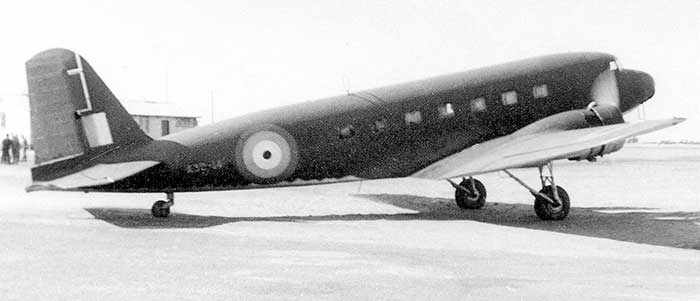
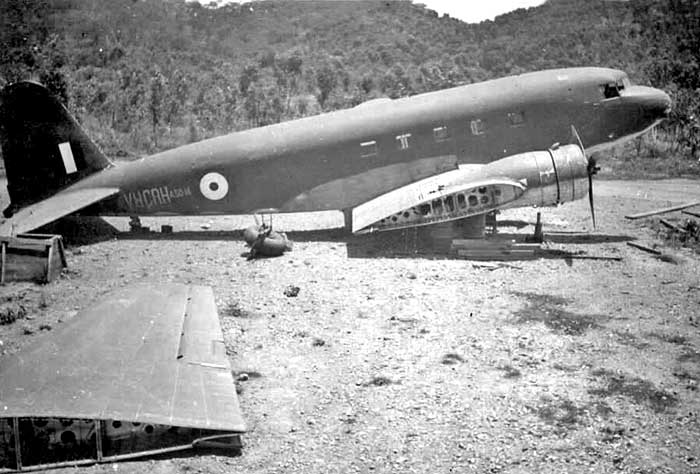
Note the repainted roundel but still with centre red circle. National Library of Australia E.A.Crome collection
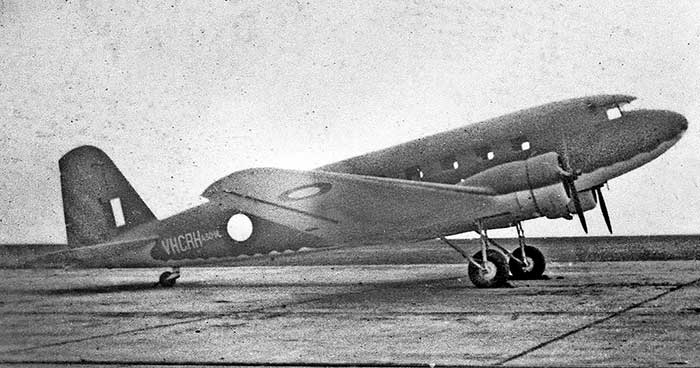
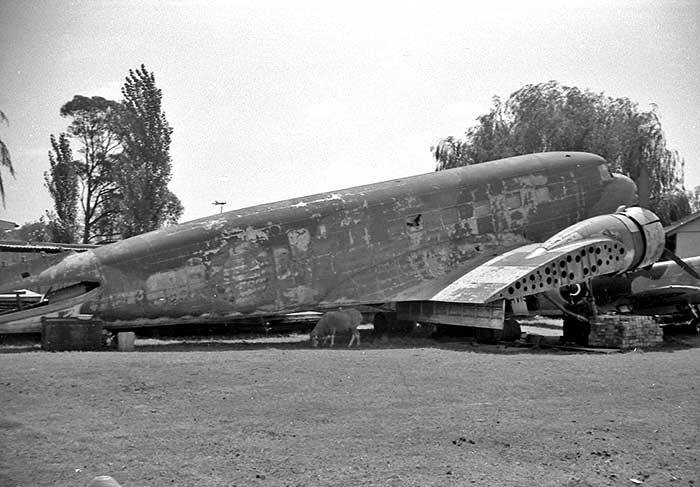
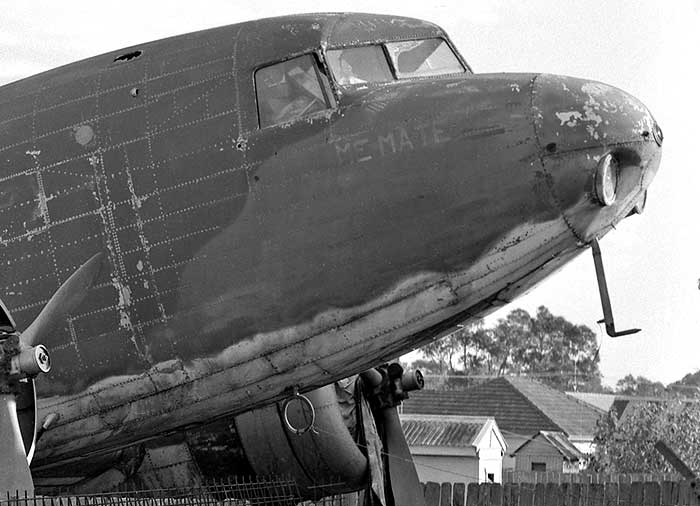



In early 1936 the Netherlands Government had requested Australian Government approval for KNILM to operate Batavia-Sydney, but response was slow, mired in British Empire politics sought to protect the existing Imperial Airways-Qantas Empire Airways service London-Singapore-Batavia-Brisbane. In January 1937 KNILM senior personnel took advantage of an unexpected DC-2 charter flight to Sydney to travel on the aircraft to Sydney to have personal talks with Australian government officials. Just like the KLM DC-2 in the 1934 MacRobertson Air Race, once again the speed and passenger comfort of the KNILM DC-2 was obvious compared to the Qantas DH.86 biplanes. The new Lockheed Super Electras which KNILM proposed for the Australian route had an even better performance.
Australian Government approval was granted on 30 April 1937. The inaugural KNILM passenger service Batavia-Sydney was flown by Lockheed 14 PK-AFM which landed at Mascot on 5 July 1938 to commence a weekly schedule. The Lockheeds on the Australian run were later supplemented with DC-2s and DC-5s: see http://www.goodall.com.au/australian-aviation/dc-5/douglas-dc-5.htm
http://www.goodall.com.au/australian-aviation/dornier-24/dornierDo24.html
http://www.goodall.com.au/australian-aviation/ww2-transport-callsigns-1/ww2transportcallsigns-1.html
Eleven KNILM airliners reached Australia. Three Lockheed 14s, three DC-5s, two DC-2s and three DC-3s although one DC-3 PK-AFV was attacked by Japanese fighters as it approached Broome, Western Australia on 3 March 1942 and made a forced landing on a beach.
In Australia the KNILM aircraft joined the Allied war effort, flying troops and supplies to the Darwin area and New Guinea.
Details on the two Dutch DC-2s:
| .35 |
Built by Douglas Aircraft Co Inc at Santa Monica, California. Model DC-2-115G, c/n 1375 |
| Built to the order
of Koninklijke Nederlandsch-Indische
Luchtvaart Maatschappij - KNILM, Batavia, Netherlands East Indies.
(Royal Dutch Indies Airways) |
|
| 12.6.35 |
Douglas delivery
date to KNILM |
| 6.35 |
Registered
PK-AFK KNILM,
Batavia |
| 3.42 |
Evacuated to Australia
ahead of the Japanese advance through Netherlands East Indies |
| Flown in Australia
by KNILM pilots on ad-hoc transport sorties in support the Allied
war effort |
|
| 3.42 |
Australian Government
documents indicate that all KNILM aircraft in Australia were to be
transferred to the Australian Government for a token £5 each. They
were planned to supplement Australian airlines, which had lost many
of their aircraft due to RAAF impressments. However General Douglas
Macarthur, Supreme Commander SWPA ordered the Dutch airliners to be
transferred to USAAF in Australia for military transport duties. |
| 19.3.42 |
Taken over by
USAAF Air Transport Command,
South West Pacific Area in a charter arrangement pending their
purchase. Flown by Dutch crews carrying US cargo and personnel in
Australia |
| Allocated temporary USAAF serial "41-1375". This was a temporary identity applied to Dutch transport aircraft taken over by USAAF in Australia during this period, Fiscal Year 41- + aircraft c/n | |
| 15.5.42 |
PK-AFK purchased
by USAAF Air Transport Command,
South West Pacific Area |
| 15.5.42 |
Directorate of
Air Transport, Allied Air Forces (DAT) was formally established to
manage military transport aircraft operations in Australia by RAAF,
USAAF and Australian civil airlines flying leased military aircraft
(Qantas, ANA, Guinea Airways). |
| DAT allocated
radio callsign VHCXF.
The first group of transport aircraft were given callsigns in the
VH-CX and VH-CA blocks, which were painted in white on the camouflaged
aircraft. |
|
| Operated by 21
Troop Carrier Squadron, 374 Troop Carrier Group, USAAF 5th Air Force:
based at Archerfield Aerodrome, Brisbane. Operated a courier service
Brisbane-Port Moresby carrying troops to New Guinea and some supplies.
Only small items of cargo could be carried because of the lack of
cargo door. |
|
| 23.6.42 |
crashed
at Charters Towers, Queensland |
| 29.7.42 |
DAT daily aircraft status list
shows CXF at Charters Towers "disassembled" |
| 14.6.44 |
USAAF book-keeping exercise
to cover the acquisition of the Dutch aircraft in Australia in 1942: Approval of Purchase Order No.44068, from Netherlands, under Order AC6838: allotment of USAAF type designation and serial number: C-32A serial 44-83226. |
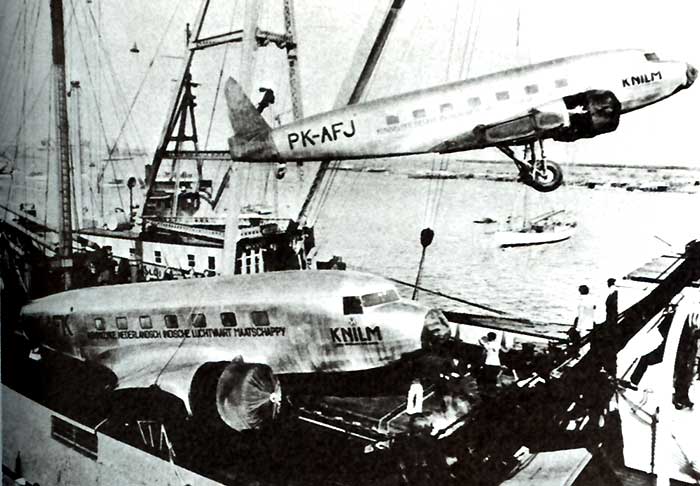
Long Beach docks, California in 1935. Fred Niven collection
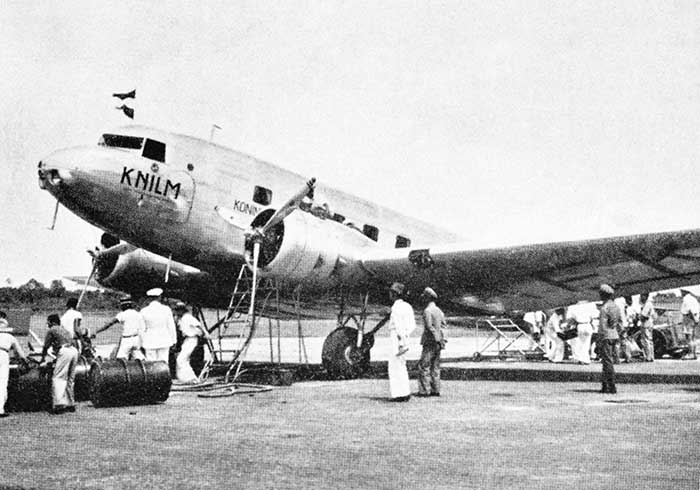
| .35 |
Built by Douglas Aircraft Co Inc at Santa Monica, California. Model DC-2-115G, c/n 1376 |
| Built to the order of Koninklijke Nederlandsch-Indische Luchtvaart Maatschappij - KNILM, Batavia, Netherlands East Indies. (Royal Dutch Indies Airways) | |
| 12.6.35 |
Douglas delivery date to KNILM |
| 19.7.35 |
Registered
PK-AFL: KNILM,
Batavia |
| 9.1.37 |
PK-AFL departed Batavia on a
special flight to Australia. The aircraft had been chartered by Sir
Laurence Philipps, Chairman of British United Steamship Company to
carry his family group to Australia when seats were unavailable on
the Qantas DH.86 service. KNILM Flying Superintendent Major Willem Carol Jahan Versteegh also travelled on the DC-2 to have discussions with the Australian Government over KNILM's application for a Batavia-Sydney service. The flight was under the command of KNILM Captain J.J.Schott with three crew. PK-AFL reached Sydney 12.1.37 and returned to Batavia 18.1.37 |
| 3.42 |
Evacuated to Australia ahead of the Japanese advance through Netherlands East Indies |
| Flown in Australia by KNILM pilots on ad-hoc transport sorties in support the Allied war effort | |
| 3.42 |
Australian Government documents indicate that all KNILM aircraft in Australia were to be transferred to the Australian Government for a token £5 each. They were planned to supplement Australian airlines, which had lost many of their aircraft due to RAAF impressments. However General Douglas Macarthur, Supreme Commander SWPA ordered the Dutch airliners to be transferred to USAAF in Australia for military transport duties. |
| 19.3.42 |
Taken over by USAAF Air Transport Command, South West Pacific Area in a charter arrangement pending their purchase. Flown by Dutch crews carrying US cargo and personnel in Australia |
| Allocated temporary USAAF serial "41-1376". This was a temporary identity applied to Dutch transport aircraft taken over by USAAF in Australia during this period, Fiscal Year 41- + aircraft c/n | |
| 15.5.42 |
PK-AFL purchased by USAAF Air Transport Command, South West Pacific Area |
| 15.5.42 |
Directorate of Air Transport, Allied Air Forces (DAT) was formally established to manage military transport aircraft operations in Australia by RAAF, USAAF and Australian civil airlines flying leased military aircraft (Qantas, ANA, Guinea Airways). |
| DAT allocated radio callsign VHCXG. The first group of transport aircraft were given callsigns in the VH-CX and VH-CA blocks, which were painted in white on the camouflaged aircraft. | |
| Operated by 21 Troop Carrier Squadron, 374 Troop Carrier Group, USAAF 5th Air Force: based at Archerfield Aerodrome, Brisbane. Operated a courier service Brisbane-Port Moresby carrying troops to New Guinea and some supplies. Only small items of cargo could be carried because of the lack of cargo door. | |
| 29.7.42 |
DAT daily aircraft status list shows DC-2 VHCXG (identity AFL) enroute Archerfield to Mascot |
| 17.8.42 |
VHCXG reportedly damaged on
ground at Seven Mile Drome, Port Moresby by Japanese bombing raid |
| 22.9.42 |
VHCXG reportedly damaged in
accident at Cooktown Qld. Repaired by 5th Air Force 61st Service Squadron (At that time Cooktown was regularly used by military transport aircraft as a refuelling stop between New Guinea and Townsville) |
| 10.43 |
Australian National
Airways, Melbourne advised the Department of Civil Aviation that it
would not be able to maintain reduced wartime civilian services without
replacement aircraft to cover their fleet losses due to the war situation.
DCA Head Office and ADAT HQ were both situated in Victoria Barracks,
Melbourne and the Department negotiated the release of DC-2 VHCXG
to ANA. |
| 21.10.43 |
Civil Registration
application: Australian National
Airways Pty Ltd, Essendon Aerodrome, Melbourne Vic. Application states c/n 1376 built at Santa Monica June 1935, "flown to Australia by a KNILM crew as PK-AFL". |
| Overhaul by ANA
at Essendon to convert to civilian airliner standard, fitted Wright
Cyclone GR.1830-G2 engines |
|
| 25.1.44 |
First test flight Essendon,
ANA Captain F.T. Patterson |
| 27.1.44 |
Next test flight by Captain
Patterson: his report included "The
aircraft performed as if an additional 400 pounds had been loaded
in the nose during tests with Centre of Gravity at furtherest aft
and forward limits." It is assumed this relates to the installation of the more powerful and heavier models of Wright Cyclone. |
| 27.1.44 |
Registered VH-ADZ:
Commonwealth of Australia operated
under charter by Australian National Airways Pty Ltd, Melbourne Vic.
Named Mengana |
| 27.1.44 |
Australian CofA issued at Essendon,
fitted for 15 passengers |
| 1.44 |
Entered ANA passenger service |
| 5.44 |
Damaged at Mildura Vic, repaired
|
| 14.6.44 |
USAAF book-keeping exercise
to cover the acquisition of the Dutch aircraft in Australia in 1942: Approval of Purchase Order No.44068, from Netherlands, under Order AC6838: allotment of USAAF type designation and serial number: C-32A serial 44-83227. |
| 10.44 |
Several DCA incident reports from Parafield Aeradio due loss of radio comms while operating Melbourne-Adelaide and Melbourne-Perth services |
| 20.8.45 |
Minor damage struck by a bullet
fired from the ground near Narrandera NSW while at low altitude for
a scheduled stop on a Wagga-Narrandera-Adelaide service. |
| 6.47 |
VH-ADZ is operating ANA's Adelaide-Ceduna-Forrest-Kalgoorlie-Perth
return services |
| 5.11.47 |
Change of ownership: Colonel
Charles Morrison McDonald, Sydney trading as Macair Charter Service
|
| Charles McDonald had formed
Macair Charter Service during 1947 to join other Australian air charter
operators on the lucrative migrant trade, flying European migrants,
many displaced by the war to Australia. Postwar demands on shipping
had caused long delays for sea travel and existing airline services
had limited seating: see http://www.goodall.com.au/migrant-caper.htm |
|
| Macair Charter Service was basd
at Bankstown Aerodrome, Sydney at the Curtis Madsen Aircafts hangar.
Chief pilot was Captain Alan Murray. The company was to operate for
less than six months. McDonald also purchased ANA Douglas C-39s VH-ARB
and ARC: see Part 5 below |
|
| 18.1.48 |
VH-ADZ arrived Mascot Aerodrome,
Sydney from Rome on Macair Charter Service's first migrant charter,
with 15 passengers. Captain A.J.Brooks reported an "uncomfortable"
delay in Calcutta, India while having a mechanical problem corrected
during the inbound flight to Australia. |
| Sydney
Morning Herald newspaper 17.3.48 report on the migrant
air charters stated “Macair
Charter Service claimed its Douglas DC-2 had been sabotaged when starting
to operate its first migration flight; the aircraft had made a forced
landing at Darwin.” |
|
| 6.48 |
DCA Mascot offcice memo: McDonald
was in debt to Arthur Carveles, a Sydney travel agent who booked migrants
in Rome and Athens for flights to Australia. Carveles took legal action
to gain ownership of Macair aircraft DC-2 VH-ADZ and C-39 VH-ARC to
resell. |
| 6.48 |
Change of ownership: Arthur Carveles trading as International Rapid Air Services, Kings Cross, Sydney |
| 8.7.48 |
Change of ownership: Sidney
D. Marshall trading as Marshall Airways, Mascot Aerodrome, Sydney |
| Sid Marshall established Marshall
Airways at Mascot prewar as a maintenance and charter business, specialising
in air ambulance flights. After the war Sid had intentions of
starting an intra-state NSW airline and purchased four RAAF disposals
DC-2s see Part 3 above. |
|
| 48 |
Ongoing correspondence between
Sid Marshall and DCA concerning his plans to use DC-2s on scheduled
airline passenger services. The DCA reponses were not encouraging,
pointing out that most NSW country town aerodromes were below standards
for a DC-2 and that the Director General was not issuing any new airline
licences at that stage. Departmental internal memos dismissed the
use of DC-2s on RPT operations due to the type's age. Marshall was
respected by Dept officers, who delayed a clear refusal, hoping he
would drop the RPT idea. VH-CDZ instead was used for a variety of passenger charters, including weekend joyrides. |
| 24.8.49 |
Reregistered VH-CDZ.
DCA had required changes to numerous civil registration letters to
avoid conflict with new International codes to become standard worldwide
in radio telephony and teleprinter messages. VH-ADZ was no longer
available because "ADZ" meant "Advise"in aircraft movement messages. |
| .50 |
Marshall Airways relocated from
Mascot to Bankstown Aerodrome where DCA leased two former RAAF Bellman
hangars to the company. (All Mascot light aircraft operators including Royal Aero Club of NSW were required by DCA to vacate their premises by 1951 to allow Mascot airport development to handle increasing airline traffic.) |
| 29.12.57 |
Port undercarriage collapsed
at Mascot Aerodrome. The aircaft had stopped on a taxiway because
of a flat tyre and was being towed clear. The tug pulled the
DC-2 in a tight turn which damaged the port undercarriage assembly
which then collapsed. The port wing settled on the ground and the
airframe suffered minor structural damage. Marshall Airways
Chief Engineer Jack Davidson fitted the port wing from A30-9 which
was in storage at Bankstown Aerodrome. |
| 14.2.58 |
Ferried Mascot-Bankstown by
Sid Marshall and Trevor Thiele |
| 2.58 |
Retired
at Bankstown. Airframe time 9,649 hours. Permanent repairs were not carried out because DCA aerodrome restrictions had by now reduced the NSW airfields to which the DC-2 could fly charters. |
| 58-65 |
VH-CDZ and RAAF DC-2s A30-9
and A30-14 were stored in or outside the Marshall Airways hangars. The dismantled DC-2 A30-11 was with other Marshall aircraft in a compound on the airfield boundary. |
| 7.3.65 |
A30-9 and VH-CDZ removed from
Marshall's second hangar and towed on their wheels by the Marshall
Airways truck from Bankstown to Camden Airport, south of Sydney. Sid Marshall had leased the second hangar to his neighbour Aerial Agriculture Pty Ltd which need more hangarage. In return Marshall was given use of a Camden hangar leased by Aerial Agriculture. |
| c71 |
The Camden hangar lease ended.
VH-CDZ and A30-9 were moved to a block of land in the nearby town
of Narellan. Parked in the open with outer wings removed. |
| .72 |
Sold to Maurice
J. Whittington, trading as Hendon Aeroplane Company, Sydney NSW. Whittington was a vintage aircraft dealer who had previously traded under the name Stag Lane Flight. Whittington also acquired Marshall aircraft DH.80 Puss Moth VH-UQB and Short Scion VH-UUP, which were sold to a British collector. |
| .72 |
VH-CDZ resold to US citizen
Captain Richard M. Rosser,
Confederate Air Force, Harlingen Texas |
| 4.6.72 |
Towed from Narellan back to
Bankstown Airport. Rosser was reported as planning to have Hawker
De Havilland at Bankstown overhaul the aircraft for issue of a United
States FAA Certificate of Airworthiness. He would then fly the DC-2
to USA. |
| VH-CDZ was mostly parked outside
at Bankstown during the rest of the 1970s |
|
| 10.7.80 letter from Australian
Deparment of Transport to The Curator Netherlands National Aerospace
Museum, Amsterdam in reply to a query on acquiring VH-CDZ. "The
Minister for Home Affairs, who is responsible for preserving the National
Heritage has advised that because of the rarity of the DC-2 and its
association with early aviation in Australia, no application to export
the aircraft should be approved. This Department agrees with that
advice so no Authority to Export would be issued." Compiler's note: one wonders how this ruling can be reconciled against A30-14's export to The Netherlands in 1988. |
|
| 11.81 |
Registered N8486D
Richard M. Rosser |
| c83 |
Acquired by Mike
Wansey, Confederate Air Force (Australian Wing), Newcastle NSW |
| c83 |
Overhaul to airworthy condition
commenced in a hangar at Bankstown, |
| c85 |
Reported that the stripped fuselage
was standing on its undercarriage when unauthorised visitors entered
the cabin. As they moved forward to the cockpit, their weight caused
the fuselage to pivot on the undercarriage and the tail rose and struck
the hangar roof before falling heavily back to the hangar floor. Overhaul abandoned due to airframe structural damage. |
| 95 |
The DC-2 was now reporedly owned
by International Air Parts
Pty Ltd, Bankstown Airport. IAP was a parts business which also dealt in military-disposals aircraft on the warbird market |
| Stored dismantled at Bankstown
at the rear of a hangar |
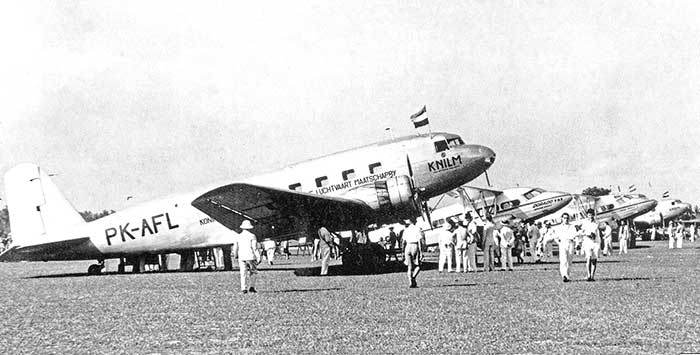
another KNILM DC-2 behind. The comparison with the British wood and fabric biplanes is obvious.
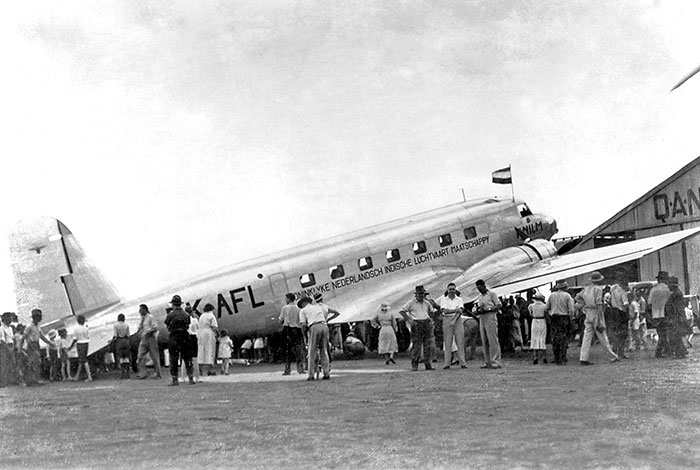
KNILM
DC-2 PK-AFL attracts a crowd at Archerfield Aerodrome, Brisbane, probably
during its
January 1937 charter flight to Australia. Fred Niven collection
January 1937 charter flight to Australia. Fred Niven collection
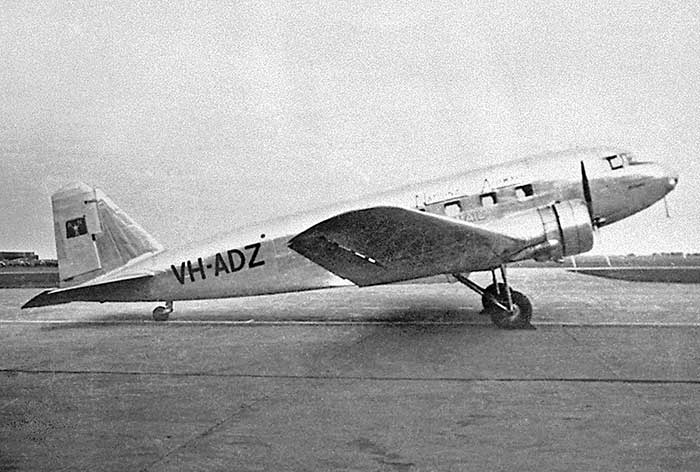
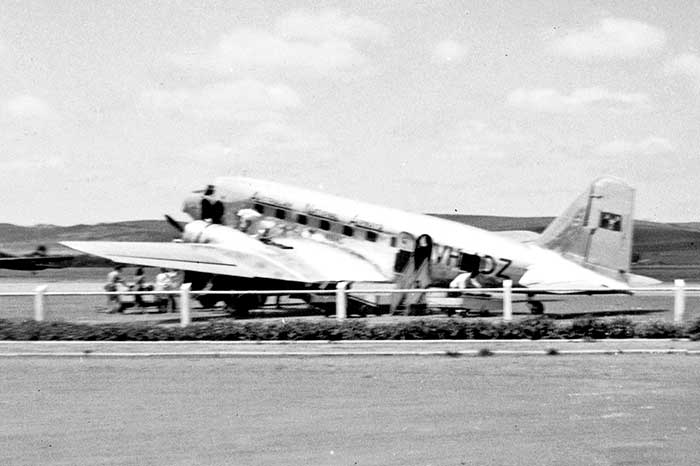
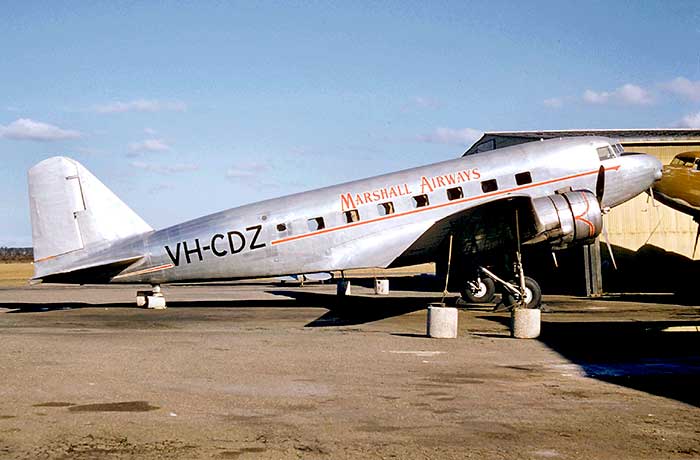


Marshall
Airways DC-2s VH-CDZ (front) and A30-9 at Bankstown 7 March 1965 being
prepared to be towed
on their main wheels by road to Camden Airport for continued storage. Photo by Peter Limon
on their main wheels by road to Camden Airport for continued storage. Photo by Peter Limon
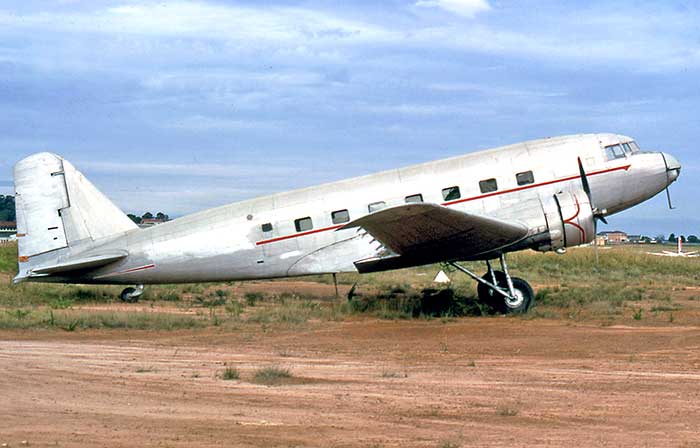
Unfortunately the overhaul back to airworthy was never completed. Photo by Chris O'Neill


Two C-33s and at least nine C-39s were operated in Australia.
Douglas C-33: DC-2 with cargo door, reinforced floor, enlarged DC-3 design fin and rudder. 750hp Wright R-1820-25s
Douglas C-39: C-33 fuselage and wings, DC-3 centre-section, undercarriage and tail unit. 975hp Wright R-1820-55s
Three C-39s were loaned to Australian National Airways in 1943, when the type was often referred to as the DC-2 and a Half.
Two of the ANA C-39s went on to post-war civil use with Guinea Air Traders in New Guinea.
| .36 |
Built by Douglas Aircraft Co Inc at Santa Monica, California, c/n 1510 |
| US Army Air Corps
order for 18 C-33s, military cargo version of DC-2 with enlarged tailplane,
reinforced floor and 1.6 metre (5 ft 9 inches) wide cargo loading
door on port side. |
|
| 22.10.36 |
Accepted by USAAC
as C-33 36-77 |
| 8.2.37 |
Assigned
Hickam Army Airfield, Honolulu |
| 25.10.42 |
Assigned New Caledonia |
| Operated a military courier service between Noumea, New Caledonia and Brisbane | |
| Directorate of Air Transport Allied Air Forces issued radio callsign VHCBF which was painted over the camouflage on the aircraft | |
| 12.43 |
Crashed
Tontouta Field, Noumea |
| 13.12.43 |
Stricken from
USAAF strength |
| .36 |
Built by Douglas Aircraft Co Inc at Santa Monica, California, c/n 1516 |
| US Army Air Corps order for 18 C-33s, military cargo version of DC-2 with enlarged tailplane, reinforced floor and 1.6 metre (5 ft 9 inches) wide cargo loading door on port side. | |
| 30.11.36 |
Accepted by USAAC as C-33 36-83 |
| .37 |
Assigned
Langly Army Airfield, Virginia |
| 6.40 |
Assigned Patterson
AAF, Dayton Ohio. |
| - |
Assigned New Caledonia |
| 42 |
Operated a military
courier service between Noumea, New Caledonia and Brisbane |
| Directorate of Air Transport Allied Air Forces issued radio callsign VHCBG which was painted over the camouflage on the aircraft | |
| 31.3.42 |
Stricken from
USAAF strength. |
| 2.39 |
Completed by Douglas Aircraft Co Inc at Santa Monica, California, c/n 2059 |
| Built to USAAC order as a C-39-DO serial 38-501 Wright R-1820-55 Cyclone engines | |
| 2.3.39 |
Delivered to USAAC as 38-501. |
| Assigned transport
radio callsign VHCDZ |
|
| 2.44 |
Stricken from USAAF strength |
| 3.39 |
Completed by Douglas Aircraft Co Inc at Santa Monica, California, c/n 2062 |
| Built to USAAC order as a C-39-DO serial 38-505. Wright R-1820-55 Cyclone engines | |
| 15.5.39 |
Delivered to USAAC as 38-505. |
| 5.8.41 |
Assigned
Nichols Field, Manila, Philippines |
| 19.12.41 |
Departed Nichols Field, Manila with General MacArthur's party evacuated to Australia during the Japanese invasion of Philippines. Arrived Darwin 22.12.41 |
| Assigned transport radio callsign VHCCA. Named Anne | |
| 25.5.42 |
Crashed
after takoff, destroyed, Alice Springs NT |
| Due to poor weather conditions,
the captain had delayed departure for more than three hours. Carrying
cargo of tracer ammunition urgently needed in Darwin by RAAF.
Immediately after the night take off, the aircraft stalled, crashed
and burned in a desert area close to the airfield. All nine
occupants were killed: Crew (21st Troop Carrier Squadron): 2nd Lt Russell L. Callison 2nd Lt William A. O'Neill Pvt Martin J. Law Pvt Rolfe M. Smith Passengers: 2nd Lt Aubrey Lawless Tobias F/Lt Duncan Matheson, LAC James Emmanuel Skillen Investigation found the total weight of the aircraft was 2,762 pounds above the calculated Maximum Takeoff Weight (MTOW) allowable at the time of the accident. |
| 5.39 |
Completed by Douglas Aircraft Co Inc at Santa Monica, California, c/n 2065 |
| Built to USAAC order as a C-39-DO serial 38-508. Wright R-1820-55 Cyclone engines | |
| 6.6.39 |
Delivered to USAAC as 38-508. |
| Assigned transport radio callsign VHCCC. | |
| Returned to USA. |
|
| 6.5.43 |
Stricken from
USAAF strength: "Surveyed" Rome Air Depot, New York |
| 13.7.39 |
Completed by Douglas Aircraft Co Inc at Santa Monica, California, c/n 2076 |
| Built to USAAC order as a C-39-DO serial 38-519. Wright R-1820-55 Cyclone engines | |
| 18.7.39 |
Delivered to USAAC as
38-519. Delivered to Selfridge Army Airfield, Michigan |
| 12.2.40 |
Assigned 5 Transport Squadron, Patterson AAF, Ohio |
| 7.10.40 |
Assigned Brookley AAF, Alabama |
| 11.12.41 |
Assigned Mines AAF, Los Angeles California |
| 11.1.42 |
Assigned Brookley Field, Alabama |
| 25.2.42 |
Assigned Mines Field, Los Angeles for packing for shipping |
| 9.3.42 |
Assigned USAAF 5th Air Force, Australia |
| 9.4.42 |
Received at Commonwealth Aircraft Corp, Fishermans Bend, Melbourne Vic for assembly |
| 24.4.42 |
Unpacking and
assembly completed at CAC, fitted with 14 passenger seats |
| 25.4.42 |
Delivered to 5th
Air Force in Australia ex CAC. Named Andrea Operated by USAAF transport units between Australia and New Guinea |
| Directorate of Air Transport Allied Air Forces issued radio callsign VHCCG which was painted over the camouflage on the aircraft | |
| 29.7.42 |
DAT daily movements list shows C-39 CCG No.519 at Essendon, engine overhaul, ready in a week. |
| .42 |
Forced landing
Dalby Qld |
| 1.5.43 |
Assigned 39 Troop Carrier Squadron, 317th Troop Carrier Group, Brisbane |
| 7.43 |
Loaned to Australian
National Airways Pty Ltd, Melbourne to be operated on military
transport duties as instructed by Directorate of Air Transport. ANA
to maintain the aircraft and provide an ANA Captain for each
military sortie, DAT to provide a RAAF or USAAF copilot. |
| 3.7.43 |
Australian CofA application:
Australian National Airways
Pty Ltd owned by US Army Air Forces. To be operated by ANA under radio callsign VHCCG, no Australian civil registration will be issued. Application quotes USAAF serial 38-519, c/n 2076, built Santa Monica 13.7.39, Wright G1820-F55s. |
| 3.7.43 |
DCA give approval for ANA to
commence operating VHCCG pending formal issue of CofA. Fitted for 2 pilots and 15 pasenger seats. |
| 7.7.43 |
CofA No.X11 issued for VHCCG,
in a DCA special series of X-prefix CofAs for military transport aircraft
operated on loan to Australian civil airines under wartime agreements
|
| 7.12.43 |
Port wing struck by USAAF refuelling
truck at Archerfield Qld. Repairs completed 15.12.43. |
| 16.12.43 |
Test flown Archerfield after
repair, departed on USAAF charter |
| 8.3.44 |
ANA pilot log: A. Fache: CCG flown 2 hrs 35 mins |
| 15.3.44 |
ANA pilot log: A. Fache: CCG flown 2 hrs 20 mins |
| 6.4.44 |
CofA renewal overhaul completed
by ANA at Essednon |
| 20.4.44 |
DAT letter to ANA advising that C-39 CCG would be replaced by a C-49 and that ANA is requested to retain and store CCG until a decision is made on its future use. |
| 3.5.44 |
Returned
to USAAF by ANA |
| Correspondence from 5th Air
Force Colonel Elsmore to Ivan Holyman, ANA Managing Director advising
of the availability of 11 USAAF surplus transport aircraft which had
potential for use by civil airlines. |
|
| VHCCG
resumes being operated by ANA. (DCA aircraft file has
no reference to this) |
|
| 1.8.44 |
pilot log: RAAF copilot Dick
Bampton, with ANA Captain Browne, and RAAF F/Sgt Freeman: CCG night courier service Archerfield-Port Moresby "Engine failure 100 miles north Osprey reef at 0410 at 7000 feet. Lost height to 100 feet in 30 minutes. Finished trip at sea level in bad weather conditions." |
| 31.8.44 |
USAAF "Condemned", ie. Struck-off
Charge |
| 11.44 |
US Foreign Economic Administration
correspondence with DCA regarding military aircraft that have been
declared surplus and are available for disposal to Australian airline
operating companies on a cash basis. A total of 12 aircraft are listed: C-39s, ex-Dutch Lodestars, DC-3s and a DC-5. - includes Douglas C-39 38-519 Located Essendon with ANA, airframe time approximately 4,500 hours. “fly-away condition after pre-flight inspection” |
| c1.45 |
Purchased ex US Foreign Liquidation Commission by Australian National Airways Pty Ltd, Melbourne |
| 2.45 |
DCA memo: CCG at Essedon is now fitted with passenger seating similar to DC-2. Hostess buffet and lavatory are being installed. No soundproofing or cabin trim. |
| 6.2.45 |
Official sale date from US Government to ANA Pty Ltd |
| 25.5.45 |
Australian CofA issued in standard
airline category. Operating as callsign VHCCG |
| 2.6.45 |
Letter from DCA to ANA Chief
Engineer Mr. Jack Stubbs, Essendon: - an inspection of CCG on 1 June 1945 revealed that the conversion to passenger aircraft had been carried out in a very unsatisfactory manner, especially attachment of passenger and hostess seating and structure of a rear baggage locker. Engineering drawings were not submitted to DCA for approval and it is understood they have not yet been drawn, despite the modifications being carried out 3 months ago. - DCA Senior Inspector Aircraft at Essendon was criticised for renewing the CofA without confirming that the passenger modifications had been submitted and approved. - before CCG may resume operation for public transport, ANA must supply proof that all modifications are airworthy and approved. |
| 5.6.45 |
DCA became aware that ANA continued
to operate VHCCG on civil scheduled passenger services without complying
with DCA ruling it not fly until drawings for passenger modifications
were submitted and approved. DCA suspends the CofA until the
matter is resolved. (No file record of how many days) |
| 10.45 |
VHCCG used on ANA scheduled services Essendon-Mildura-Broken Hill |
| 23.11.45 |
ANA pilot log Alf Fache: CCG Sydney-Canberra-Essendon-Nhill-Adelaide |
| 10.12.45 |
ANA pilot log Alf Fache: CCG Adelaide-Essendon-Canberra-Sydney |
| 1.46 |
DCA file references to incidents
while CCG operating ANA services to Tasmania: reports of high engine
temperatures and electrical system failures experienced by CCG and
CCH. |
| 21.1.46 |
Press report of first post-war
Douglas service from Wynyard direct to Melbbourne, operated by VHCCG
under command of ANA Captain R.Way, who had flown it Essendon-Wynyard
earlier that day. |
| DCA terminated wartime arrangements
for military transport aircraft operated by Australian airlines and
required all aircraft to comply with normal procedures for issue of
civil registration and CofA. |
|
| 6.5.46 |
Australian Civil Registration
application: Australian National
Airways Pty Ltd, Melbourne Application forms for CCG, CCH and DC-5 CXC were submitted to DCA with the same letter from ANA which stated "Import of these aircraft was approved on 20 February 1946." |
| 24.5.46 |
Added to Australian Civil Register
as VH-ARB |
| 29.5.46 |
DCA Airport Manager Essendon memo to DCA Head Office states that C-39s CCG and CCH are parked with wings removed in the open behind an ANA hangar at Essendon. Wings are stored. |
| 11.46 |
DCA internal memos discuss what action the Department would take should ANA wish to put their two stored C-39s VH-ARB and ARC into passenger service. DCA does not want DC-2 types in post-war airline use because of poor climb performance. Head Office decides to defer a decision. |
| 7.11.47 |
DCA approve ANA request to ferry
C-39s VH-ARB and VH-ARC from Essendon to Sydney displaying their current
markings VHCCG and VHCCH. |
| 17.1.48 |
Change of ownership: Colonel Charles Morrison McDonald, Sydney trading as Macair Charter Service |
| 2.4.48 |
ANA letter to DCA stating that
the sale of VH-ARB (ex CCG) has fallen through and ANA request to
ferry it from Mascot to Essendon. Approved |
| 28.5.48 |
Change of ownership: Guinea
Air Traders, Lae, New Guinea |
| 16.8.48 |
Letter to DCA from GAT: VH-ARB
was recently flown to Darwin "where it is grounded due defects apparently
the result of sabotage". GAT sent C-39 VH-ARC from Sydney to Darwin with two spare engines and two engineers. Both engines were changed and VH-ARB ferried back to Sydney. Since then much maintenance work has been carried out on the aircraft in Curtis Madsen Aircraft's hangar at Bankstown. |
| 7.49 |
GAT advise DCA that work on VH-ARB is finally due to be completed and it will be ready for test flight at Bankstown on 11.7.49 |
| 14.7.49 |
CofA renewed Bankstown. Weighed on DCA scales at Bankstown and Load Charts prepared, freighter cabin with 4 passenger seats |
| 11.49 |
GAT write to DCA stating that
they now wish to fit seating for 23 native passengers, using USAAF
standard Norseman bench seats, as already fitted to their Hudson VH-BLA.
DCA approves. |
| 23.12.49 |
Loss of radio report in New
Guinea while on a passenger flight |
| 24.1.50 |
Letter to DCA from GAT Chief
Engineer Tom J.Watson: request VH-ARB payload be increased by 500
lbs for short flights in New Guinea. Freighter floor similar to C-47.
|
| Retired at Lae Aerodrome, New
Guinea |
|
| 13.7.50 |
CofA expired. Not renewed. |
| Stripped for parts on side of airfield. Reportedly sold to Mandated Airlines for parts, unconfirmed |
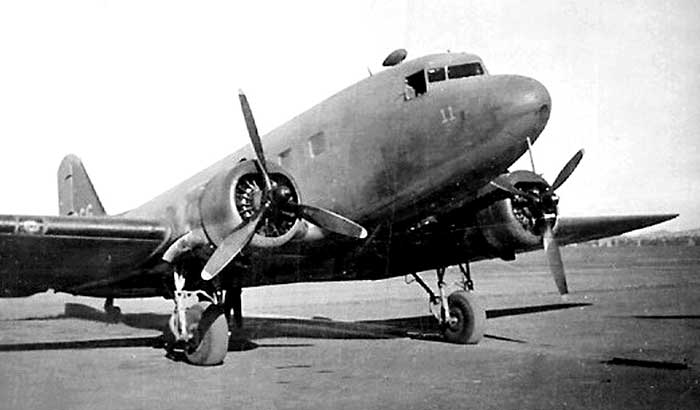
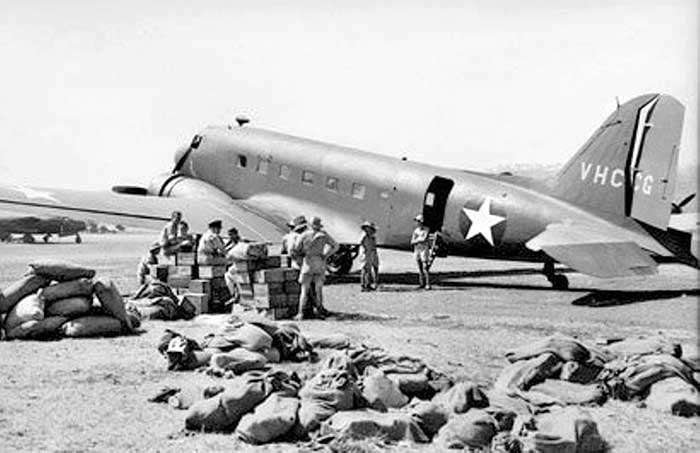
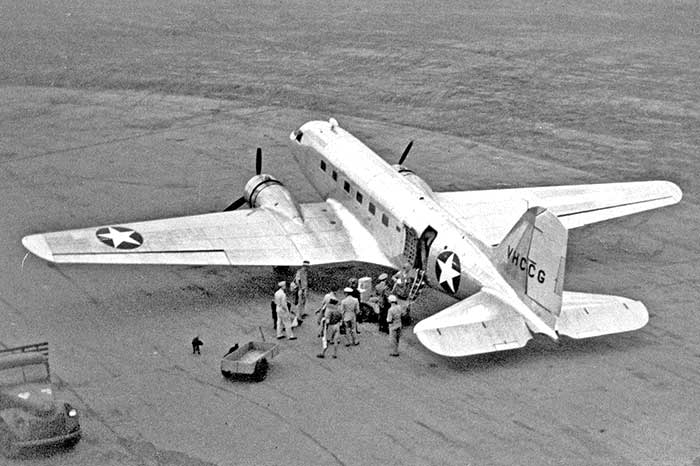
Photo: David Vincent collection
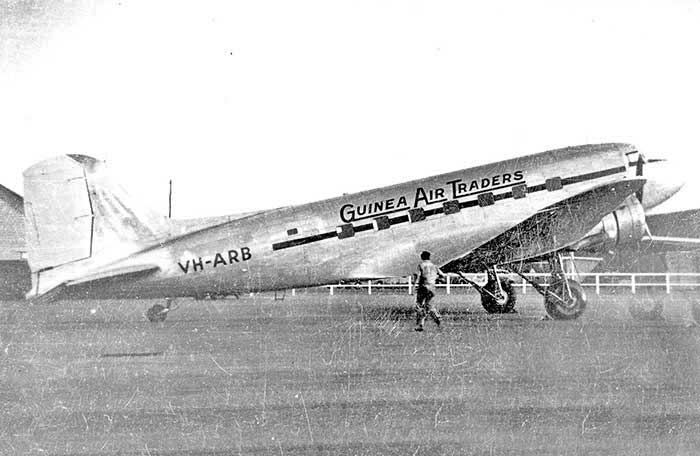
Photo by Gus Grulke
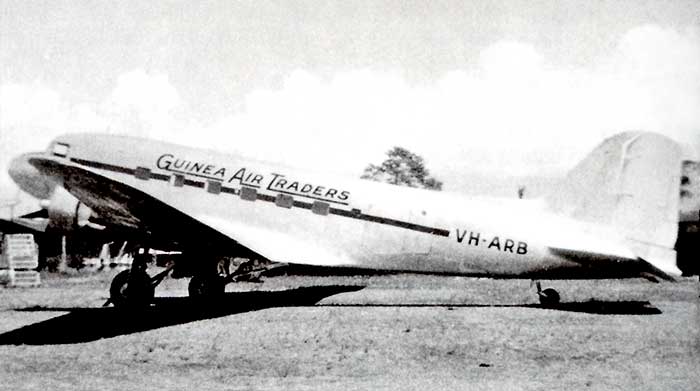
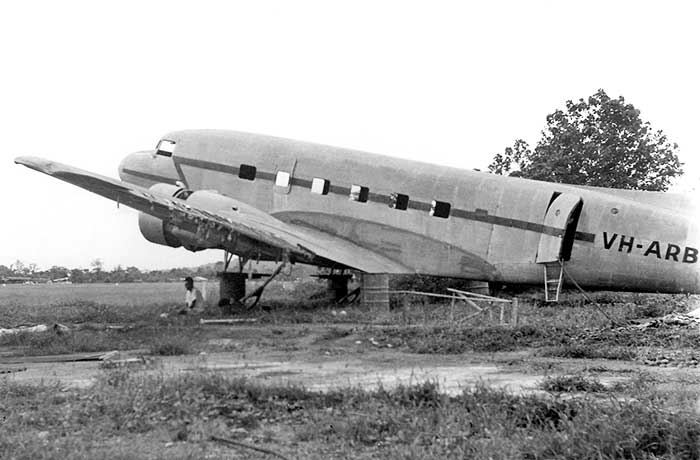
| 7.39 |
Completed by Douglas Aircraft Co Inc at Santa Monica, California, c/n 2084 |
| Built to USAAC order as a C-39-DO serial 38-527. Wright R-1820-55 engines | |
| 7.8.39 |
Delivered to USAAC as 38-527 |
| Assigned transport radio callsign VHCCD | |
| 19.11.43 |
Stricken from
USAAF strength |
| 8.9.39 |
Built by Douglas Aircraft Co Inc at Santa Monica, California, c/n 2087 |
| Built to USAAC order as a C-39-DO serial 38-530. Wright R-1820-55 Cyclone engines | |
| 18.8.39 |
Delivered to USAAC as C-39 38-530 |
| 19.9.38 |
Assigned Olmstead Army Airfield, Pennsylvania |
| 8.2.42 |
Assigned San Antonio Air Depot, Texas |
| 17.2.42 |
Assigned Douglas Aircraft Co for mods |
| 28.2.42 |
Assigned Mines AAF, Los Angeles California for shipping and packing |
| 9.3.42 |
Assigned USAAF 5th Air Force, Australia |
| 9.4.42 |
Received by Commonwealth Aircraft Corporation at Fishermans Bend Vic for assembly |
| 26.4.42 |
Assembly completed at CAC |
| 27.4.42 |
Delivered to
USAAF in Australia. Operated by USAAF 21 Troop Carier Squadron between Australia and New Guinea |
| Directorate of Air Transport Allied Air Forces issued radio callsign VHCCF which was painted over the camouflage on the aircraft | |
| 29.7.42 |
DAT daily movements list shows C-39 CCF (No.530) Archerfield-Townsville-Archerfield |
| 1.5.43 |
Assigned 39 Troop Carrier Squadron. Named Galahad |
| 28.5.43 |
Assigned 317 Troop Carrier Squadron |
| 16.12.43 |
Letter to DCA from Assistant Director, Directorate of Air Transport (DAT), "due to the loss of Qantas Empire Airways Lodestar CAB in the New Guinea accident, C-56 CAF is to be transferred from ANA to QEA and C-39 CCF is to be transferred from USAAC (sic) to ANA." |
| 16.12.43 |
CCF delivered Townsville-Archerfield for handover to ANA |
| 23.12.43 |
Australian CofA application:
Australian National Airways
Pty Ltd owned by US Army Air Forces. To be operated by ANA under radio callsign VHCCF, no Australian civil registration will be issued. Application quotes USAAF serial 38-530, c/n 2087, built Santa Monica 8.9.39, Wright G1820-65s. |
| 1.1.44 |
Australian CofA No.X14 issued for VHCCG, in a DCA special series of X-prefix CofAs for military transport aircraft operated on loan to Australian civil airines under wartime agreements |
| 25.1.44 |
Pilot log: CCF forced landing
Kempsey NSW due engine trouble. ANA Captain Stewart Hack, copilot
Dick Bampton and RAAF Sgt. Bray. Engine changed, CCF ferried Kempsey-Brisbane
31.1.44 |
| 8.3.44 |
Pilot log: ANA Captain A. Fache:
CCF 3 hrs 5 mins. |
| 9.3.44 |
Pilot log: ANA Captain A. Fache: CCF 2 hrs 35 mins. |
| 9.3.44 |
Crashed
forced landing near Molesworth Vic due engine power loss. Major
damage. ANA Captain Leslie N. Dunn, RAAF F/O A. Turner, carrying a total of 15 US and Australian troops, no injuries. Had departed Essendon at 10.46am for Mascot, encountered severe icing and lost engine power. Captain decided to make a forced landing but aircraft over ran clear area, both outer wings torn off by trees. |
| 3.44 |
Wreck transported by road to Essendon Airport |
| 20.4.44 |
Assistant Director Air Transport DAT wrote to DCA advising that wreck of CCF is held by ANA, who have been requested to retain and store CCF until a decision is made on its future use. |
| 11.44 |
US Foreign Economic Administration
correspondence with DCA regarding USAAF military aircraft that have
been declared surplus and are available for disposal to Australian
airline companies on a cash basis. A total of 12 aircraft are listed: C-39s, ex-Dutch Lodestars, DC-3s and a DC-5. - includes Douglas C-39 38-530 total time approximately 4,500 hours. Status: non-repairable as result of crash, salvage for parts. Located Essendon Aerodrome, Melbourne with ANA. |
| Wreck purchased by Australian
National Airways Pty Ltd, Essendon Aerodrome Vic |
|
| 45 |
Due wartime shortage of civil
aircraft ANA considering a rebuild of VHCCF |
| 45 |
DCA reserved registrations VH-ARA
to VH-ARD for 3 USAAF C-39s and a DC-5 purchased by ANA. VH-ARA was
reserved for VHCCF in the event it was rebuilt, but not taken
up |
| Not rebuilt by ANA, stripped
for parts at Essendon, sold for scrap. |
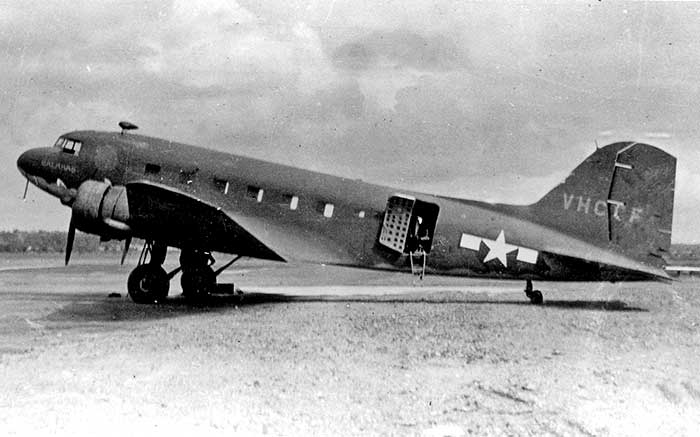

Photo: John Hopton Collection
| 8.39 |
Completed by Douglas Aircraft Co Inc at Santa Monica, California, c/n 2089 |
| Built to USAAC order as a C-39-DO serial 38-532. Wright R-1820-55 engines | |
| 17.8.39 |
Delivered to USAAC as 38-532. Delivered to San Bernadino Army Airfield, California |
| .39 |
Assigned 3rd Transport Squadron, Duncan AAF |
| 2.2.42 |
Damaged on landing Duncan AAF, Texas |
| 20.2.42 |
Assigned Douglas Aircraft Co |
| 25.2.42 |
Assigned Mines AAF, California |
| 9.3.42 |
Assigned 5th Air Force, Brisbane. Shipped to Australia. |
| 9.4.42 |
Received at Commonwealth Aircraft Corp, Fishermans Bend, Melbourne for unpacking and assembly |
| 26.4.42 |
Assembly by CAC completed |
| 27.4.42 |
Delivered to USAAF. Operated by USAAF transport units between Australia and New Guinea |
| Directorate of Air Transport Allied Air Forces issued radio callsign VHCCH which was painted in white over the aircraft's camouflage. Name on nose Down and Go | |
| 1.5.43 |
Assigned 39 Troop Carrier Squadron, 317th Troop Carrier Group |
| 2.5.43 |
Received by Commonwealth Aircraft Corporation at Fishermans Bend Vic for engine change and overhaul |
| 4.6.43 |
Completed at CAC and delivered |
| Loaned by USAAF to Australian National Airways Pty Ltd, Melbourne to be operated on military transport duties as instructed by Directorate of Air Transport. ANA to maintain the aircraft and provide an ANA Captain for each military sortie, DAT to provide a RAAF or USAAF copilot. | |
| 5.6.43 |
Australian CofA application:
Australian National Airways
Pty Ltd owned by US Army Air Forces. To be operated by ANA under radio callsign VHCCH, no Australian civil registration will be issued. Application quotes USAAF serial 38-532 c/n 2089 |
| 5.6.43 |
CofA No.X8 issued for VHCCH, in a DCA special series of X-prefix CofAs for military transport aircraft operated on loan to Australian civil airines under wartime agreements |
| 5.6.43 |
Commenced operation by ANA |
| 7.6.43 |
Forced landing Mascot due engine oil pressure. Cpt. Vern Cerche, F/O Dunn |
| 23.6.43 |
CCH delayed Parafield due engine trouble. |
| 17.3.44 |
CofA renewed at ANA Essendon |
| 30.3.44 |
Port tailplane struck by US vehicle while unloading passengers and freight at DAT hangar at Archerfield. Repaired overnight, departed on normal DAT schedule next morning |
| 20.4.44 |
Assistant Director Air Transport wrote to ANA advising that CCH would be replaced by a C-49 and that ANA is requested to retain and store CCH until a decision is made on its future use. |
| 4.5.44 |
Returned to USAAF by ANA |
| 11.44 |
US Foreign Economic Administration
correspondence with DCA regarding military aircraft that have been
declared surplus and are available for disposal to Australian airline
operating companies on a cash basis. A total of 12 aircraft are listed: C-39s, ex-Dutch Lodestars, DC-3s and a DC-5. - includes Douglas C-39 38-532 located Essendon, “fly-away condition after pre-flight inspection” |
| c1.45 |
Purchased ex US Foreign Liquidation Commission by Australian National Airways Pty Ltd, Melbourne |
| 6.5.46 |
Civil Registration Application:
Australian National Airways
Pty Ltd, Essendon. Applications for CCG, CCH and CXC submitted to DCA with the same letter from ANA which stated "Import of these aircraft was approved on 20 February 1946." |
| 24.5.46 |
Added to Register as VH-ARC |
| 29.5.46 |
Memo to DCA Head Office from DCA Airport Manager, Essendon: C-39s CCG & CCH are parked with wings removed in the open behind an ANA hangar at Essendon. Wings are stored. |
| 7.11.46 |
DCA approves ferry flights of
CCG & CCH in those markings from Essendon to Mascot. Not carried
out. |
| 11.46 |
DCA internal memos discuss what action the Department would take should ANA wish to put their two stored C-39s VH-ARB and ARC into passenger service. DCA does not want DC-2 types in post-war airline use because of poor climb performance. Head Office decides to defer a decision. |
| 7.11.47 |
DCA approve an ANA request to ferry C-39s VH-ARB and VH-ARC from Essendon to Sydney displaying their current markings VHCCG and VHCCH. |
| 24.11.47 |
Australian CofA issued as VH-ARC |
| 7.12.47 |
Change of ownership:
Colonel Charles Morrison McDonald, Sydney NSW, trading as Macair Charter
Service |
| 8.12.47 |
Letter to DCA McDonald on letterhead Macair Charter Service c/- Curtis Madsen Aircrafts, Bankstown: he intends to install 15 passenger seats in VH-ARC which is presently a freighter. "I have a contract to carry a few loads of migrants to Australia on a charter basis.". Will then be used for freight work |
| 1.48 |
Cabin interior being lined and
seating installed, should be ready to depart overseas within two weeks.
Due to depart Australia on 6.2.48 |
| 12.2.48 |
Weighed on DCA scales at Bankstown for calculations to prepare new Load Charts for passenger seating |
| 11.3.48 |
Engines damaged at Darwin, aircraft
grounded. VH-ARC remained at Darwin for the next 4 months, by which time Macair had ceased operations |
| 17.3.48 |
Sydney Morning Herald newspaper
report on migrant charter flights from Europe : “Macair Charter Service claimed its Douglas DC-2 had been sabotaged when starting to operate its first migration flight. The aircraft had made a forced landing at Darwin.” |
| Macair was formed with the original
intention of developing the air freighting of valuable livestock between
Australia and New Guinea as pioneered by Guinea Air Traders. But the
Macair DC-2 VH-ADZ and C-39 VH-ARC were diverted to passenger carrying,
mainly on European migrant charters. However few, if any, flights
to Rome were completed and Macair had ceased operating by May 1948.
|
|
| 18.6.48 |
Change of ownership: Arthur
Carvelles, Rapid Air Service International, Sydney NSW. Arthur Carveles was a Sydney suburban pharmacist who also operated a travel agency, chartering seats on aircraft of Intercontinental Air Tours, Sydney and Macair to carry migrants from Europe to Australia. McDonald had been in debt to Carvelles, who took legal action to acquire Macair aircraft to protect his investment. |
| 21.6.48 |
Change of ownership: Guinea
Air Traders Ltd, Lae. W. W. Alderton, GAT Director advised DCA that GAT will shortly send two replacement Wright Whirlwind engines to Darwin to be installed in VH-ARC. |
| 7.48 |
DCA wrote a bland letter to
GAT advising that the Department intended to reduce the Maximum All-Up
Weight (MAUW) for C-39 type aircraft, based on recent DC-2 performance
flight testing. |
| 12.7.48 |
Angry response to DCA from GAT
Director W.W.Alderton: "Had we known
that your Department proposed to reduce the effective payload by practically
50%, we would certainly not have purchased them." He emphasised
that the two GAT C-39s are fitted with more powerful models of Wright
Cyclones to the DC-2. |
| 25.7.48 |
VH-ARC ferried Darwin-Sydney
after engines replacement and maintenance |
| 29.7.48 |
GAT Director Alderton wrote
to DCA offering VH-ARC for performance testing at Bankstown. He expresses
confidence that such testing will show that an increase (not reduction)
in payload and MAUW can be achieved. VH-ARC is currently having
maintenance by Curtis-Madsen Aircrafts at Bankstown and will be available
next week. |
| 8.48 |
Engines of VH-ARC found to
require more work. Engine parts have been sent to ANA. GAT then swapped Cyclone G2s from VH-ARB to VH-ARC so that the DCA flight tests can proceed |
| 19.8.48 |
Weighed on DCA scales at Bankstown
in preparation for a series of flight performance tests. GAT pilot for performance flight testing is Captain John Dalrymple, who previously flew C-39s for ANA |
| 8.48 |
As a result of the flight performance tests in VH-ARC, DCA agreed to leave C-39 MAUW at the original 21,000lb |
| 29.8.48 |
CofA renewed at Bankstown, fitted
with 14 passenger seats and toilet |
| 9.48 |
Based at Lae. |
| GAT pilot Tom Deegan remembered
the two C-39s: "ARC had been shot up with holes during the war. Hundreds of little holes in the fuselage, patched and rivetted. Those C-39s had small engines in them and they'd ice up if you flew in cloud. Carburettor would ice up. You'd be flying along with hot air underneath the carburettor and lose half your power. I started off GAT's Lae-Goroka-Madang-Wewak-Manus Island-Kavieng-Rabaul return service in a C-39. The people were very grateful. It was a weekly service and they got mail instead of waiting for ships." |
|
| 14.12.48 |
Sydney Airport Customs log:
VH-ARC arrived Sydney from Lae, Captain J. Dalrymple GAT |
| 16.3.49 |
Damaged
in heavy landing at Kerowagi, New Guinea |
| 8.51 |
DCA Sydney office memo: VH-ARC
is at Bankstown in u/s condition. |
| Assumed
had been shipped damaged from New Guinea for possible rebuild.
A DCA file report in 5.49 states VH-ARC was owned by Mandated Airlines
with no mention of damage. |
|
| 6.8.51 |
Struck-off Register, owner still
GAT |
| 10.51 |
Walter E. James, Managing Director
of South Coast Airways, Wollongong wrote to DCA enquiring about operational
requirements for the C-39 type. James states that he intends to purchase
a C-39 from Mandated Airlines (sic) for his Sydney-Cowra airline service. |
| 3.54 |
VH-ARC fuselage and wings reported at Bankstown |
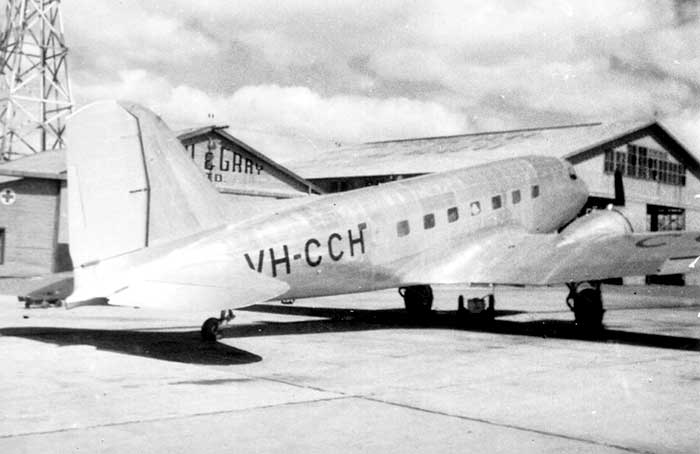
C-39
VHCCH at Essendon circa 1944 while operated by ANA, devoid of USAAF or
ANA markings.
Civil
Aviation Historical Society Alan Betteridge Collection
| 9.39 |
Completed by Douglas
Aircraft Co Inc at Santa Monica, California, c/n 2092. |
| Built to USAAC
order as a C-39-DO serial 38-535. Wright R-1820-55 engines. This was the final C-39 of the order for 35 aircraft. |
|
| 28.9.39 |
Delivered to USAAC as 38-535 |
| Assigned transport radio callsign VHCCE. Named Hot to Go | |
| Returned to USA |
|
| 10.44 |
Stricken from
USAAF charge. USAAF record card indicates sold surplus to a commercial operator, but no subsequent civil career traced |
DC-2 N39165's arrival at RAAF Laverton near Melbourne on 5 February 1984 to replicate the arrival of the original Uiver in the 1934 air race attracted a large crowd. It was a major event for the Australian Dutch community and local vintage aircraft flew in to add atmosphere to the occcasion.
It was a hot summer day with parched and dusty airfield grass - very different from the mud and rain of Uiver's famous night landing on the Albury racecourse. The following pictures were taken that day at Laverton by Geoff Goodall.
 `
`
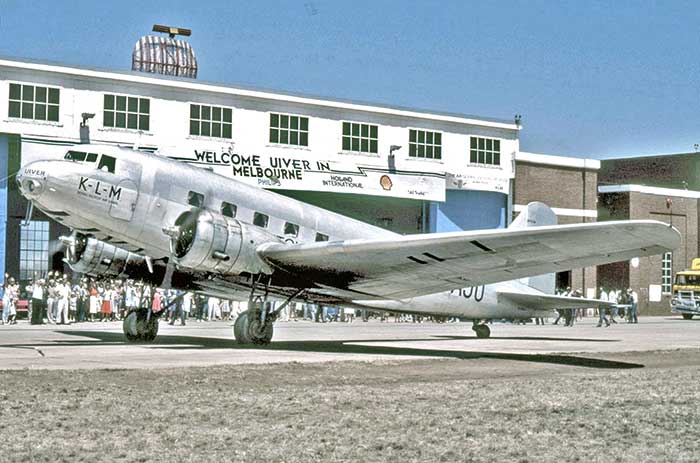
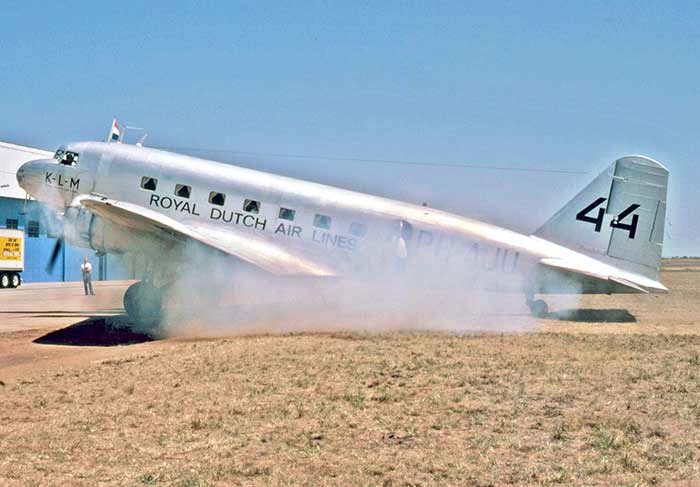

- Australian Civil Aircraft Register, Department of Civil Aviation, Melbourne
- DCA aircraft files, National Archives of Australia, Melbourne and Perth
- RAAF records, RAAF Air Historical Section, Canberra
- The Douglas DC-3 and its predecessors, J.M.G.Gradidge, Air Britain, 1984
- McDonnell Douglas Aircraft since 1920, Rene J. Francillon, Putnam 1979
- Flypast: a record of aviation in Australia, Neville Parnell & Trevor Boughton, AGPS 1988
- US Military Aircraft Designations and Serials, J.M.Andrade, Midland Counties Publications, 1979
- War without Glory, John Balfe, Macmillan, 1984
- And Far From Home, Flying RAAF Transports in the Pacific War and after, John Balfe, Macmillan 1985
- Outback Airman, Harry Purvis with Joan Priest, Rigby, 1979
- There and Back, Alan Randall, self-published Melbourne 1983
- Air Crash Vols 1 & 2, Macarthur Job, Aerospace Publications, Canberra 1992
- Cootamundra Aerodrome, Ben Dannecker, privately published 1976
- Balus - The Aeroplane in Papua New Guinea, Volume 1, James Sinclair, Robert Brown & Associates (Australia) 1986
- Airlines and Aircraft of the Ansett Group 1921-2002, Fred Niven, Edition 12
- DC-2 Down In The Sea, Robert Kendall Piper, Wings magazine, NZ, Autumn 1985
- The Douglas DC-2, James Kightly, Flypast magazine, Melbourne, November 2006
- DC-2 In Australian Service, Eric Allen, Australian Aviation magazine, March 1983
- Douglas DC-2 At War, Arthur Pearcy, Aviation News magazine, 24 January 1985
- Significant Dutch Flights in Dutch-Australian aviation history, draft, Noel Jackling
- Noel Wilson Webster GM, interview and details of A30-8 ditching, Lex McAulkay, Maryborough Qld
- Return To Service, George McBride, Flightpath magazine
- Australian Douglas transport listings compiled by John Hopton, Alan Bovelt, Bob Livingstone
- The Short Happy Lives of VHCRH and Friends, John Hopton & Peter Kelly, Man and Aerial Machines No.68, May-June 1998
- Acquisition of DC-2s by RAAF, Trevor Boughton, Man and Aerial Machines No.32, November-December 1992